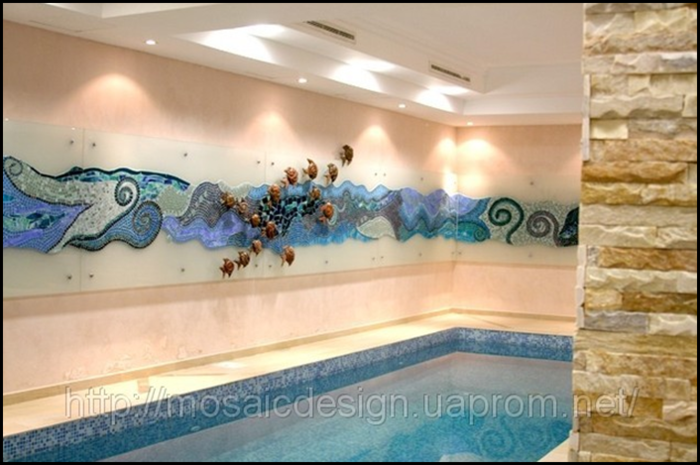Mosaic tiles in the interior
Handsome and unusual interior can be obtained using mosaic tiles. Simple technology allows you to apply absolutely any design to the tiles, which can decorate the interior and highlight your taste.
Methods of applying a pattern to mosaic tiles
Mosaic tiles can be single-colored, several transitioning or combining tones, or ingots with a specific pattern that looks like an ornament or a complete picture. So, tiles with a mono color are covered with ordinary colored glaze, but not everything is so simple with tiles that have a certain pattern. Have you ever heard about photo tiles? So, the design is applied to the tile using a special printer. The lifespan of such tiles directly depends on the quality of the print (more cheap option gives a guarantee for 5-7 years). After applying the pattern, expensive format tiles are covered with a specialvarnish that protects the design from mechanical stress (you can clean the tiles with abrasive substances) and fading, which is an automatic guarantee for at least 40 years. Thus, the mosaic tile is completely covered with paint, or the design is partially applied using a special printer.
Types of mosaic tiles
The most common type of mosaic tile is ceramic tile. Ceramics look elegant. Another advantage of ceramic tiles is their cost. Another option is glass mosaic tiles. This is a kind of novelty; glass tiles look quite unusual. In addition, just like ceramic tiles, it is resistant to moisture and temperature changes. Glass coated mosaic tiles have less thickness and surface area compared totraditional ceramics.Glass tiles are great for laying out complex and voluminous patterns, or a solid colored canvas.
Another type of mosaic tile is concrete-based tile. She has large area and is usually used for outdoor work. In comparison, ceramic and glass tiles are used in pool areas, kitchens, bathrooms and living rooms.
Relevance of tiles in the interior
Ceramic tiles are appropriate in almost any interior format and in any room for any purpose. Despite the fact that at first glance tile may seem like a “cold” material, which is applicable only inwithin the bathroom or kitchen, mosaic tiles, thanks to their patterns and variety of colors, fit perfectly into living rooms and bedrooms. In addition, tiles may not fill the entire space, but only part of it. For example, on a wall, mosaic tiles can be included as a kind of mural that will serve as an accent decoration for the room.Mosaic tiles look appropriate and relevant not only on the walls, but also on the floor. But, as noted earlier, ceramics is a cold material, therefore, if tiles predominate, then the floor must be heated. Also, the floor is often lined with several materials, which is especially typical for the kitchen. For example, within dining area the floor is made of wood (parquet, laminate), and the other, working part of the kitchen area is lined with mosaic tiles. This combination is practical and looks stylish.
Relevance of mosaic tiles
Mosaic in the interior will always attract attention, so the pattern and color must be chosen based not only on your own preferences, but also on design trends. Note that ceramic tiles can last for decades without changing color. It is this factor that should be taken into account when choosing the color direction of the mosaic palette.
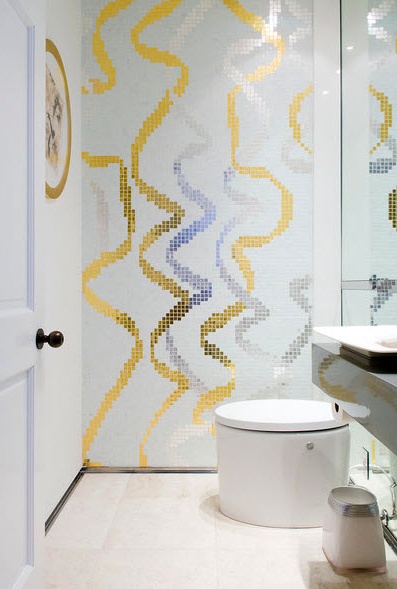
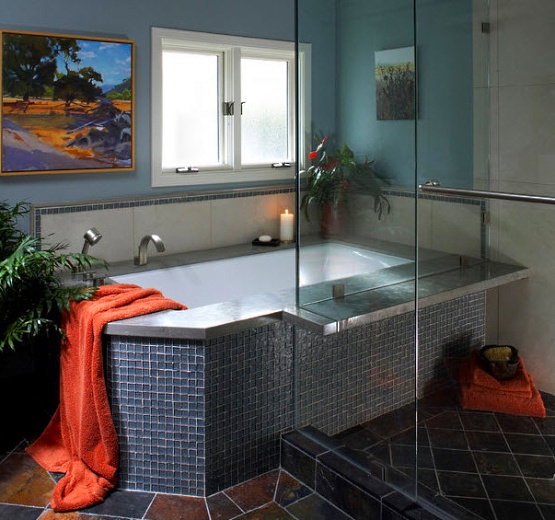
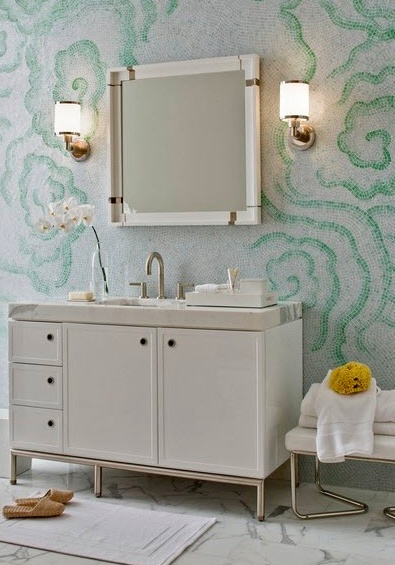
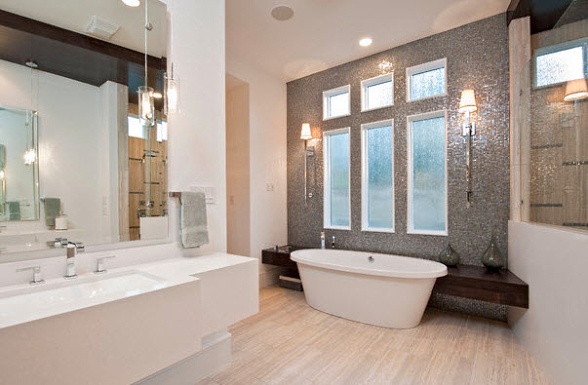


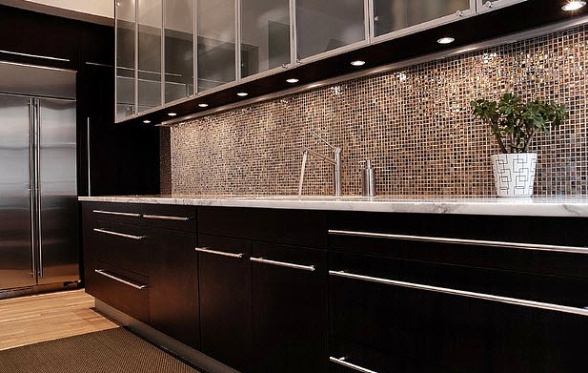

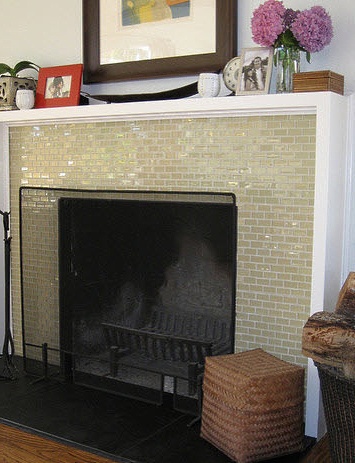


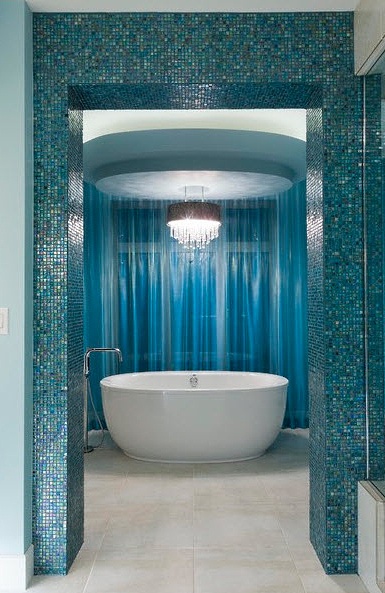
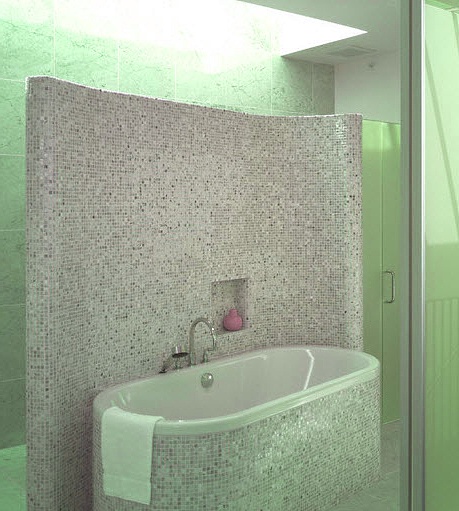

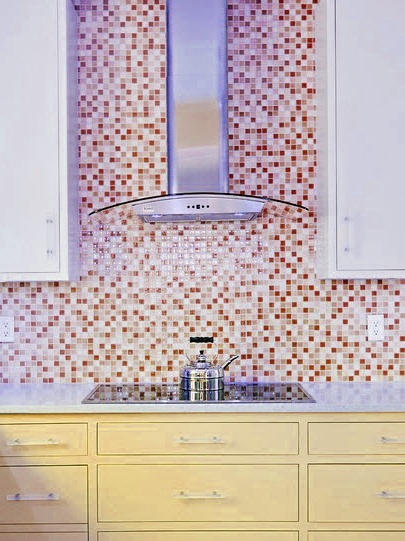
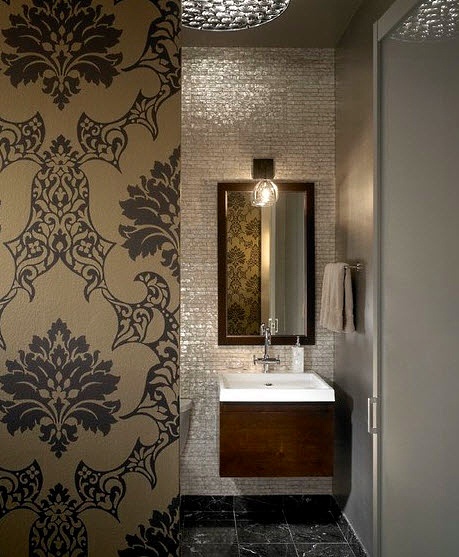
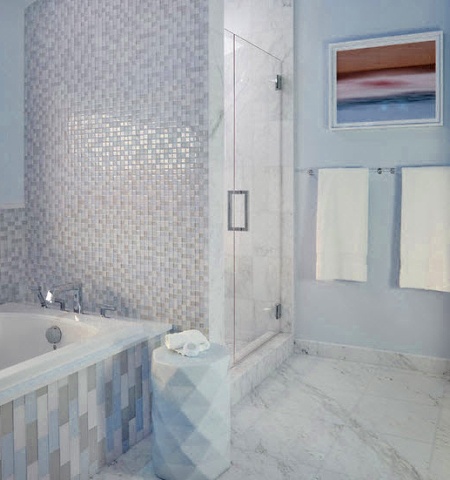
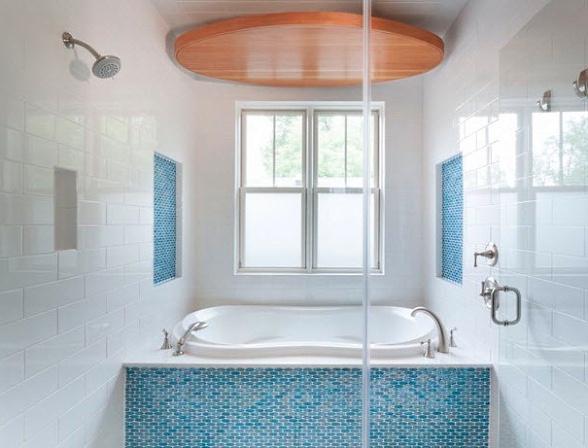
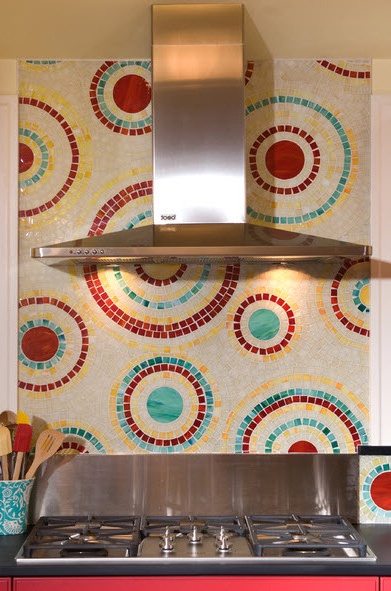
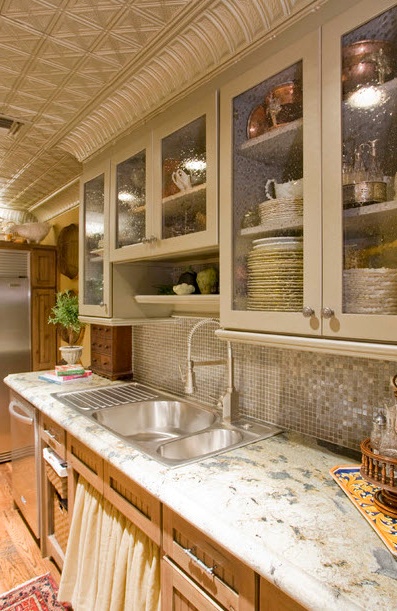
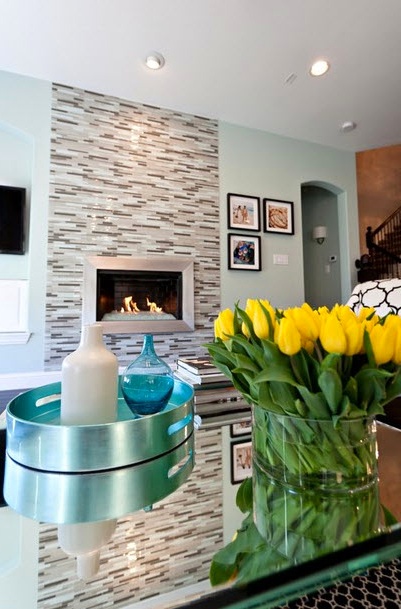
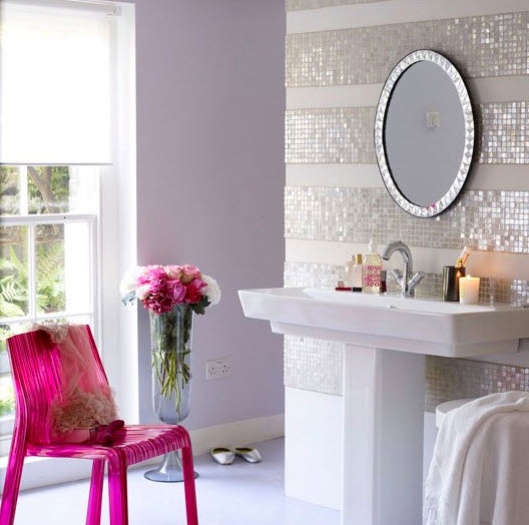

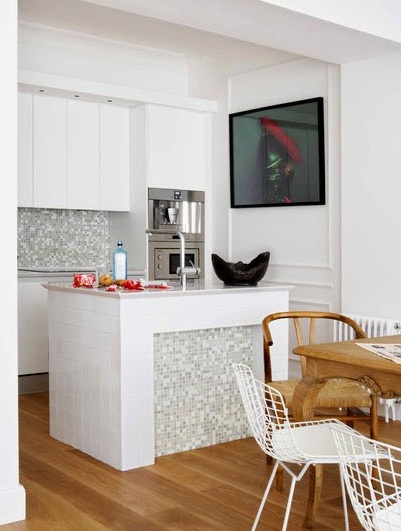

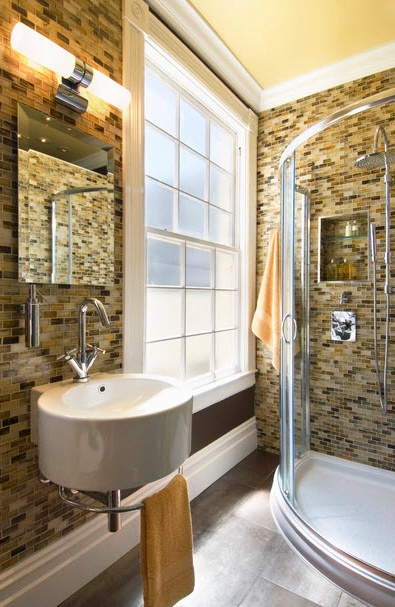
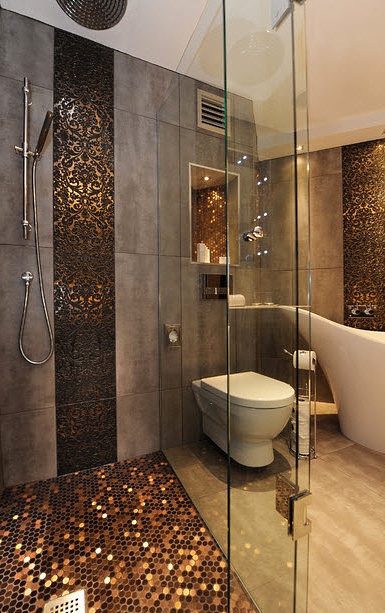


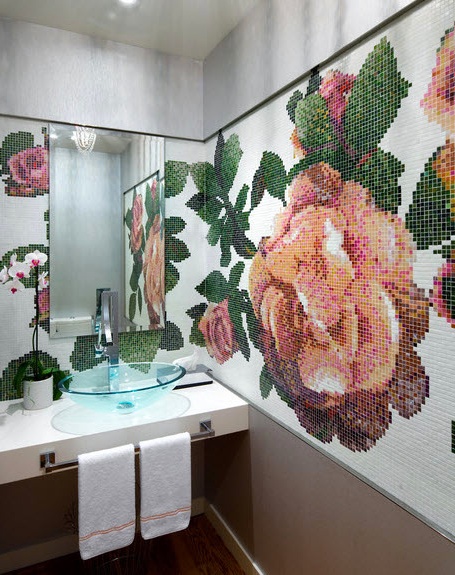
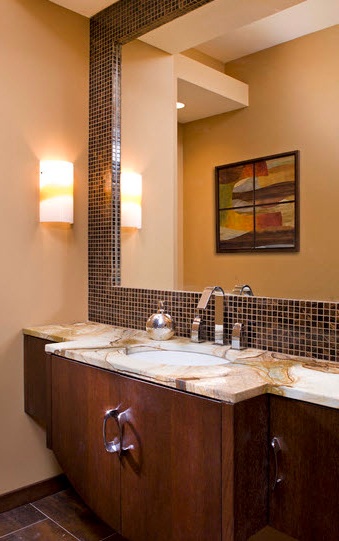
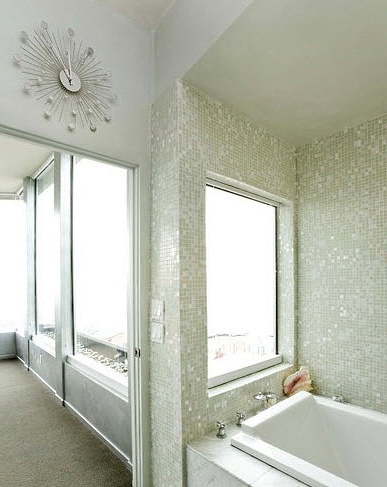

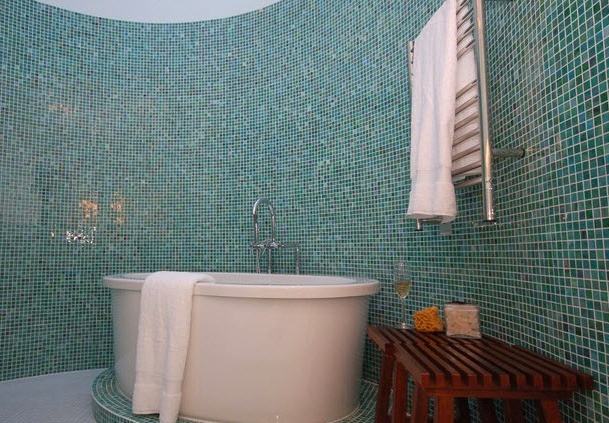

More about tiles:
Oddly enough, not many owners of houses and apartments can boast of mosaic walls, although this is a great design idea.
From mosaic pieces you can lay out various images, geometric figures and outlandish ornaments, you can use both pieces of the same tone and multi-colored ones, it all depends on your imagination and imagination.
Wall drawings, posters, and paintings can smoothly transition into mosaics. This combination of textures, tones, transitions and contrasts will make the walls of your home unique and inimitable.
If you still decide to line the walls of your house with multi-colored mosaic pieces, then don’t hesitate - this is a great idea!
The first question that arises for the owners of houses and apartments who have decided to make changes in the interior is: “In which room should the walls be laid with mosaics?” The Stylingroom team advises starting with the bedroom or bathroom. Very often these rooms are simple and faceless, because people try not to overload, for example, the sleeping area with elaborate ornaments and colorful paintings, outlandish furniture and bright decorative items.
Mosaic walls will enliven the atmosphere of the bedroom, bathroom and other rooms. The rooms will not be overloaded with unnecessary objects or furniture that are beautiful but useless and occupy all the free space.
A mosaic of calm tones will decorate the bathroom and bedroom, while maintaining its minimalism and simplicity.
Simplicity, style, harmony. Mosaic walls Brown go well with the minimalism of the room in white tones, as well as with brown wood furniture.
Just look how the mosaic decorated the living room! A banal living room in white tones, a little boring, was immediately enlivened, became more interesting and brighter with the help of a mosaic wall. At the same time, the living room retained the modesty, minimalism and simplicity inherent in its interior, which the owner of the house so sought.
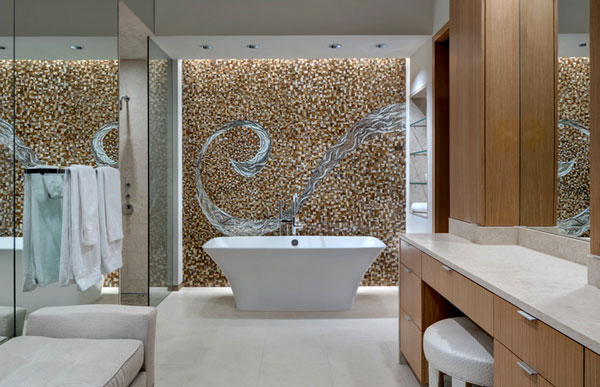
Multi-colored mosaic pieces in white, brown and blue tones that go well with light brown wood furniture and a white bathroom.
Another example: a simple, boring white bathroom, enlivened by an unusual mosaic wall. From mosaic pieces of blue, white and brown flowers the designer posted a real work of art. The mosaic pattern resembles a sandy beach that has been overwhelmed by a rapid ocean or sea wave. A truly unique atmosphere!
Sea green mosaic
We should also talk about sea green or turquoise mosaics, which are very popular among interior designers and home owners.
The color of the mosaic resembles water sparkling in the sun, which hypnotizes and enchants. Very often, to achieve the desired effect, it is enough to simply place pieces of turquoise mosaic on the wall of the house without creating any special ornament or geometric shape.
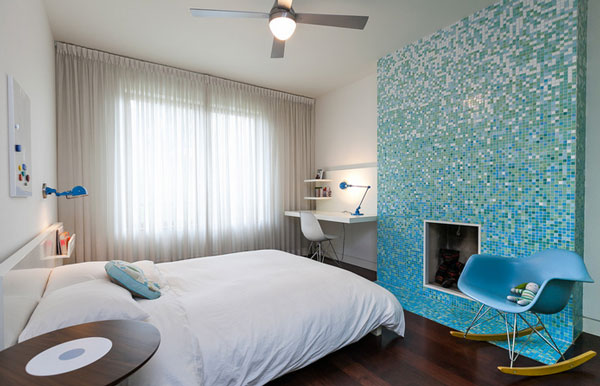
Mosaic in turquoise tones, laid out from glass pieces of blue, green, blue, white flowers, adds marine energy and harmony to the calm atmosphere of the sleep area. Lying on your bed, you can spend hours admiring the “sea” wall and remembering summer rest on the sea.
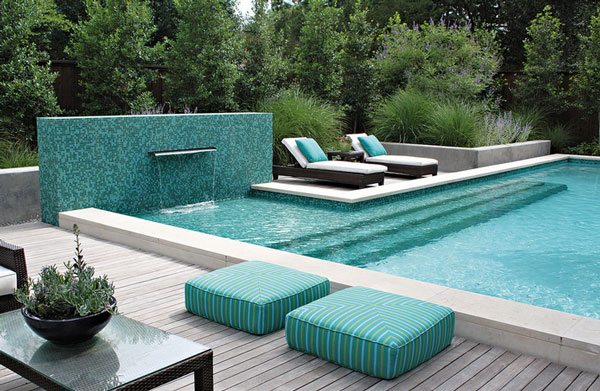
The designers of Bonick Landscaping created a truly unique pool, decorating it with turquoise mosaic slabs. Turquoise wall added artificial waterfall, which enhances the effect and makes the bathing area a real oasis or a small island in the ocean, where it is pleasant to spend free time and relax after a hard day at work. The sea-green mosaic goes well with the wooden floor of the veranda in light gray tones, white sun loungers, and turquoise pillows, which is also a great design move! 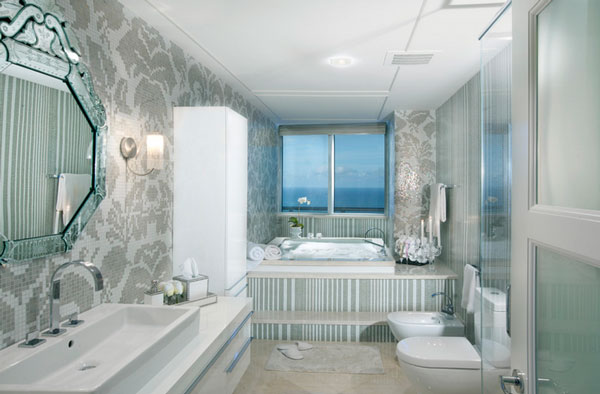
And in this photo we see how the designers of Dkor Interiors Inc unusually used sea green color in the bathroom interior. The design team gave its preference not to the standard turquoise sparkling in the sun, but to the color of gray sea or ocean waves during a light storm and bad weather.
From pieces of mosaic white and gray colors the designers laid out an unusual pattern reminiscent of raging waves or outlandish flowers, which go perfectly with standard white plumbing fixtures. The perfect combination of style, comfort and harmony.
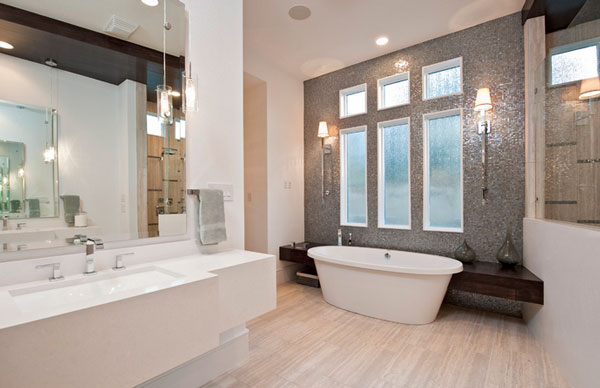
The mosaic wall in dark gray tones resembles raging ocean waves during a strong storm. The mosaic goes well with the light colors of the bathroom, and a row of windows in the mosaic wall greatly enlivens the atmosphere of the bathroom.
Variety of colors and colors
Our team likes the use of mosaics in the interior, first of all, for the opportunity to choose. The home owner or designer has a wide range of tones, colors, color schemes and combinations, ornaments and designs to choose from. There are no “right” or “wrong” colors and colors in design; the boundaries are determined only by the imagination and taste preferences of the customer or designer.
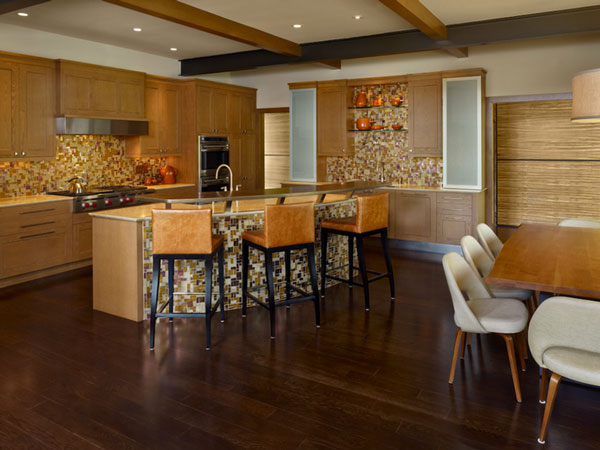
Multi-colored glass mosaic pieces in white, light and dark brown tones perfectly complemented the kitchen walls and counter kitchen table. Mosaic tiles match perfectly with kitchen wooden furniture light colors and wooden floors.
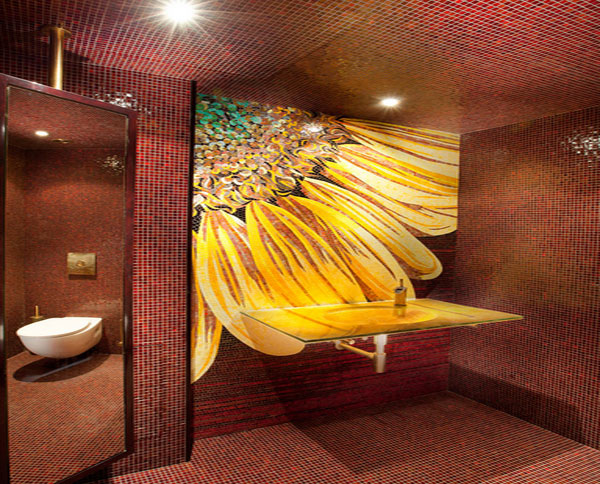
The designers of Elad Gonen created a unique sunflower pattern from multi-colored mosaic pieces, which is emphasized by the red-brown mosaic. Great idea for the bathroom!
Mosaic with sunflowers is an excellent addition for a home whose atmosphere lacks the warmth and comfort of the sun. If you are laying out any image from mosaic pieces, then be sure to take care of the correctly selected color of the mosaic for the background. The designers chose a rich red-brown color for the background, which perfectly sets off and favorably presents the yellow sunny sunflower to the audience.
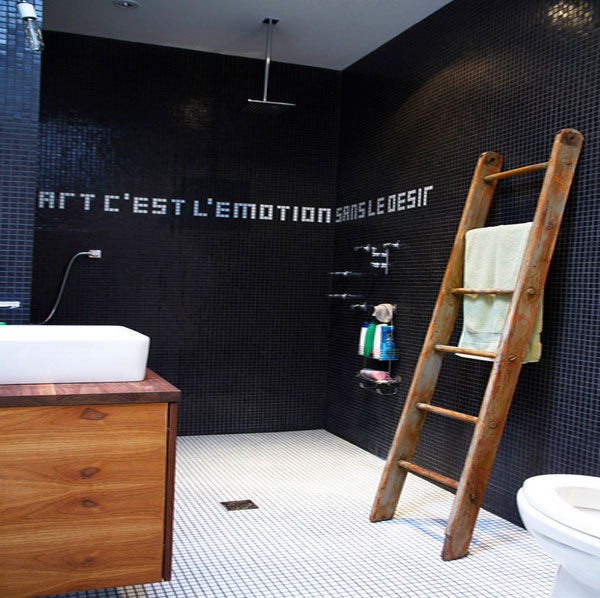
The bathroom walls, lined with a mosaic of black pieces, are decorated with the owner's favorite quote.
Another idea from our Stylingroom team: why not put your favorite quote on your wall using jigsaw puzzle pieces? What's your favorite quote? Maybe "carpe diem?" (Latin: “Seize the day”).
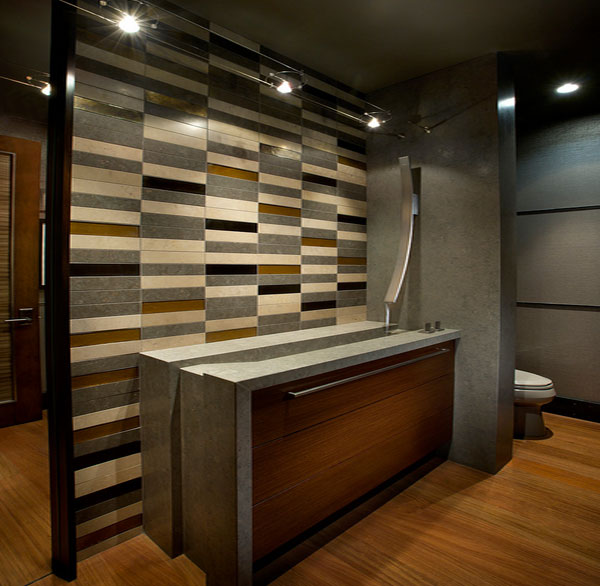
Designers IMI Design Inc. We used large rectangular mosaic strips to decorate the room, which perfectly complemented the bathroom wall. Stripes in black, white, brown and gray colors go well with gray walls bathroom and light wood floors.
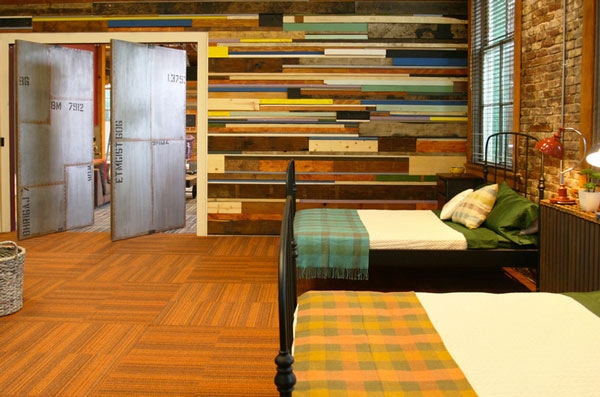
The team used small and large stripes and mosaic pieces to decorate the bedroom wall. As a result, we see a living, colorful, bright bedroom, which will appeal to fans of original and unique interiors. What is there: pieces of mosaic in the color of stone and wood, blue, green, purple, yellow... it is clear that the creators of this composition did not spare imagination and bright colors.
Unique mosaic designs
The Stylingroom team really likes the unusual designs created from mosaic pieces by talented and creative designers. We hope that you will like them too.
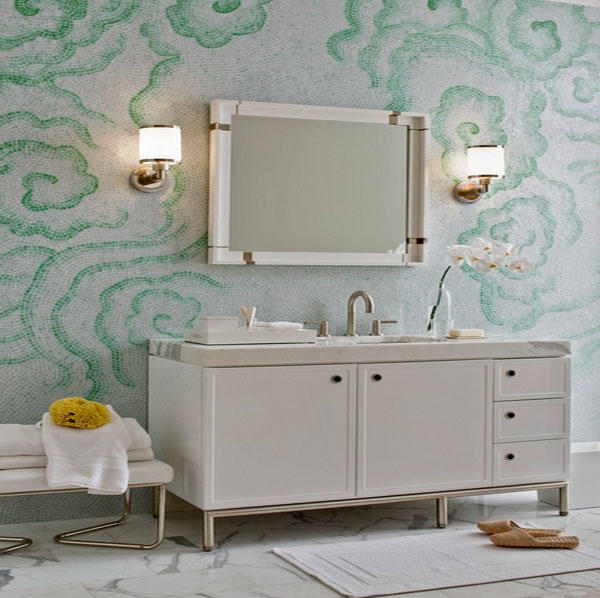
Using multi-colored mosaic pieces in white and light green tones, the designer created a unique flower arrangement, which goes perfectly with white bathroom furniture. Simplicity and minimalism at its finest!
We really like this composition. The designer laid out an original floral abstraction from mosaic pieces, reminiscent of stems, buds and petals of flowers. Looks good!
Having considered color options mosaics, it would not be amiss to turn to materials, methods self-made mosaic decor.
Ideas for mosaic walls made from various materials
Glass and smalt mosaics are the oldest traditional materials artistic technique. Pieces of transparent colored glass form the basis of an unusually bright glass mosaic. Smalt differs from it in its opaque texture, more deep color, increased strength.
Decorating an entire wall with such mosaics is now, as in ancient times, only possible for rich people. The source material is expensive (Venetian is considered the best colored glass, Murano smalt), labor-intensive work that requires artistic abilities. Therefore, modern glass mosaic is used to decorate small walls, most often the front wall of the bathroom.

Such Chinese mosaics, in ready-made panels or sets, are sold relatively inexpensively. Glass and smalt mosaics are ideal for sanitary facilities due to their brightness, picturesqueness, and water-repellent properties. The high price of mosaic design is compensated by its durability.
At self-installation glass mosaic sets you need to prepare a perfectly smooth wall. For a transparent mosaic, the wall must be white; for a smalt one, you can apply a colored pattern on which the mosaic is laid out. The adhesive for fastening must comply with the recommendations of the mosaic manufacturer.
The situation is much simpler with ceramic mosaics. You can use many types of ceramic tiles and regular tiles. Ceramic mosaics are rarely used for decorating residential premises. In the bathroom or toilet, you can decorate the mosaic wall yourself. To do this, ordinary tiles are cut into small pieces (of equal size to make work easier). For abstract designs, tiles of similar colors are chosen, for ornamental mosaics - contrasting colors.
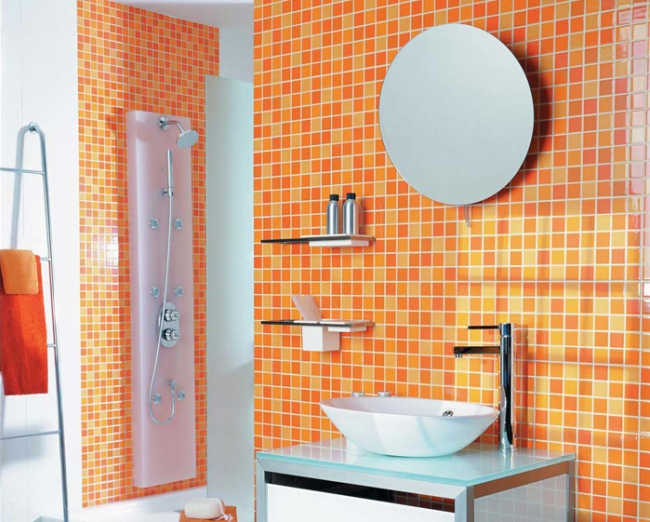
The technique of working with such mosaics is available to any craftsman familiar with laying tiles. More difficult work with different-sized pieces of tiles. Artistic inclinations are required, but having learned to cut out pieces of the desired configuration and select them by color, you can create mosaics with complex patterns from tiles. To make work easier, mosaic fragments are assembled on a cardboard sheet (with light glue), subsequently firmly fixed to the wall.
Decor full walls interior spaces stone mosaic is used extremely rarely. The peculiarities of the material make the room gloomy; a living room in this design will look like a cave. Sometimes the fireplace wall is decorated with stone mosaics. In ancient times, stone mosaics were used (and are perfectly preserved) for colorful floor designs.
But in the exterior decor, a wall with stone mosaics looks original and picturesque.

The surface of mosaic stones is usually not polished. Grinding is used for expensive materials - marble, granite mosaics.
Many projects provide for interior designs mosaic walls made of expanded clay. The material is lighter than stone, wider in color scheme. Purposeful design with expanded clay mosaics can create a stylish image in entrance halls, hallways, and separate areas of a large living room.

Expanded clay mosaics are suitable for neoclassical, rustic, and alpine styles. Usually large ornamental forms made from solid tiles are used; the material is not suitable for compositions with patterns.
Mosaic panel on the wall
Artistic mosaics with multi-colored, multi-dimensional patterns are often used as wall panels. In essence, this is a painting made not with paints, but with other materials. Specialized art studios are able to transfer copies into glass, smalt mosaics famous paintings, photos.

Such a copy of smalt can be mounted into a wall. The roundness and relief of the smalt pieces adds volume to the image and makes it change at different lighting angles. Naturally, such work is done only by hand.
Glass mosaic panel ( small size, weight) can be framed in the form of a picture, allowing installation anywhere in the interior.
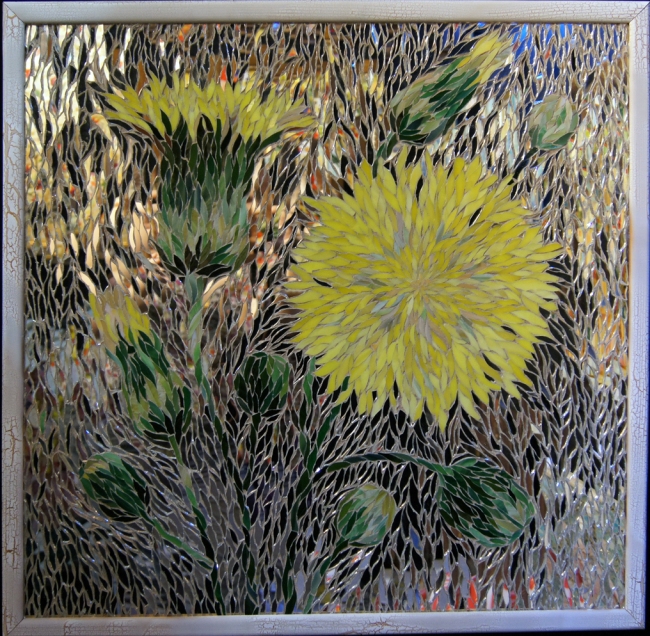
Obviously, the smaller the mosaic elements, the image turns out to be more refined and detailed. More delicate work also increases the price of a handmade mosaic panel.
The stone panels in the Russian style are extremely original. They are made, as a rule, in the Urals, where they are a traditional folk craft.

For such panels, a variety of stone materials are used, both simple (granite, quartz) and expensive - malachite, onyx, jasper. But the cost of materials is secondary compared to the labor invested and the artistic merits of the work.
Additional artistic device becomes rough grinding, revealing the texture of the stone, the play of light on the edges.
The most simple view For independent creativity in our conditions, wooden mosaic becomes. You can use almost any available materials for it. Even in urban conditions, you can collect material for such a panel from miniature saw cuts.
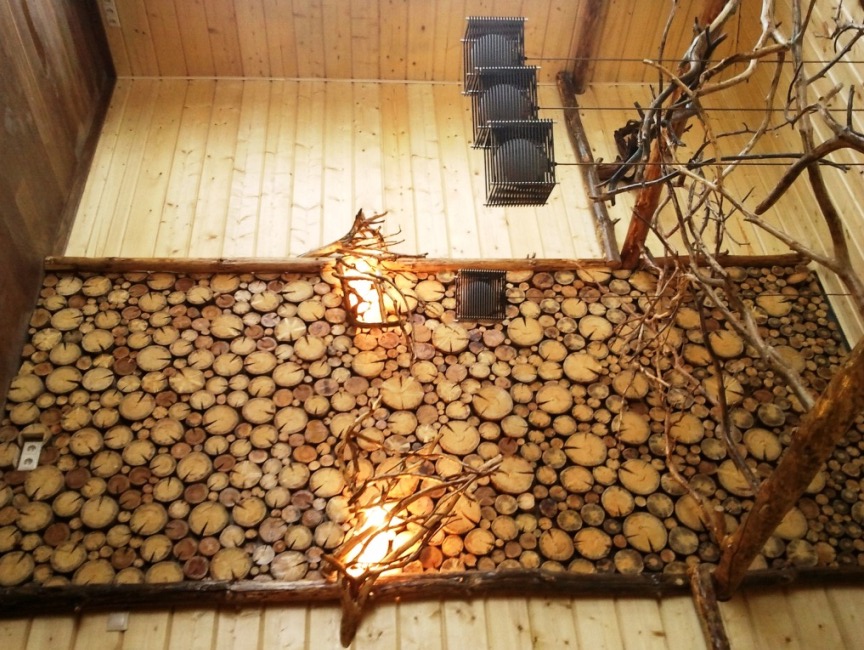
To create decorative panel from voluminous stumps - you need to live in a forest area, select original material spend several years.
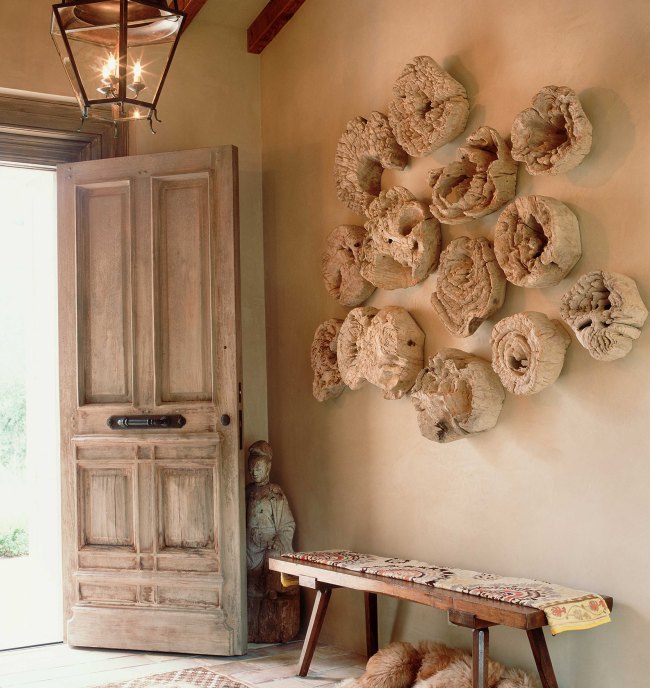
It is difficult to classify this form of decor as classical mosaic, but the original technique does not have its own stylistic name. In terms of the selection of heterogeneous textured elements, it is closer to a mosaic, although the cuts are not assembled into a single whole.
The concept of mosaic is moving further and further from its original meaning. Today, mosaics are called compositions made from pieces of leather, scraps of wallpaper, and fabric panels. An example of such an original mosaic is a panel of dry leaves.
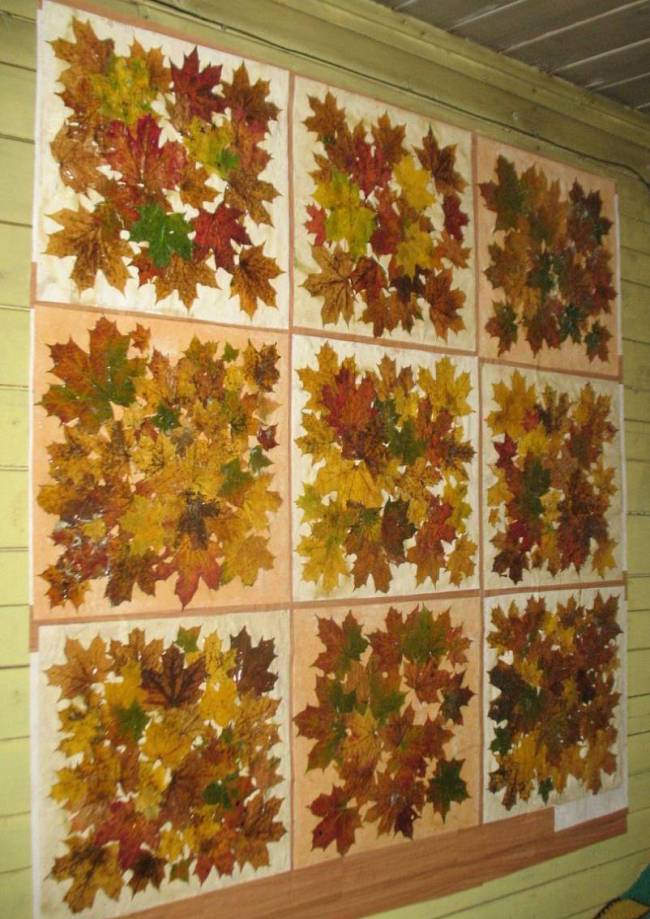
It adheres to all the principles of mosaic - stylistically homogeneous fragments are collected and arranged into an artistic whole.
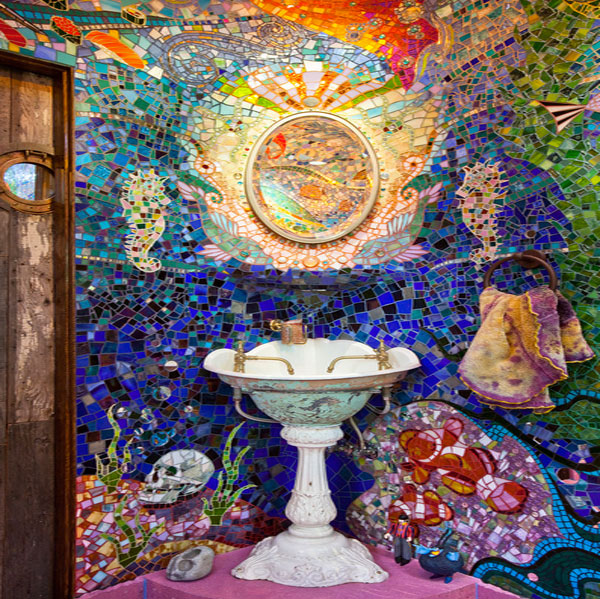
The designers decorated the wall using mosaic pieces of various shapes, colors and sizes. The result is a real masterpiece: a sea or ocean floor with tropical fish, seahorses, colorful algae and even a sunken skull, and if you look closely, you can see other hidden underwater elements.
The Stylingroom team likes to leave all the most interesting things to the end of the article, “for dessert.” This mosaic composition is one of our favorites. Here you see a unique and original mosaic, which successfully combines three main aspects of an ideal mosaic wall: good combination colors, style and history that the mosaic design carries. This bathroom will not leave anyone indifferent! It will especially appeal to lovers of sea and ocean themes, as well as children.
We hope you are convinced that with the help of multi-colored pieces of glass different forms and sizes, you can wonderfully decorate the walls of the bathroom, bedroom, kitchen, living room and other rooms by laying out unique and original drawings or solid color compositions that will enliven the atmosphere of your home. The most important thing is to turn on your imagination and use your imagination, then you will create a real masterpiece!
Many people strive to make housing cozy place for relaxation of family members, friends and acquaintances. An unusual, attractive home interior should evoke delight, surprise, and uniqueness. If you don’t know which interior will suit you best, use your imagination to make your cherished dream come true.
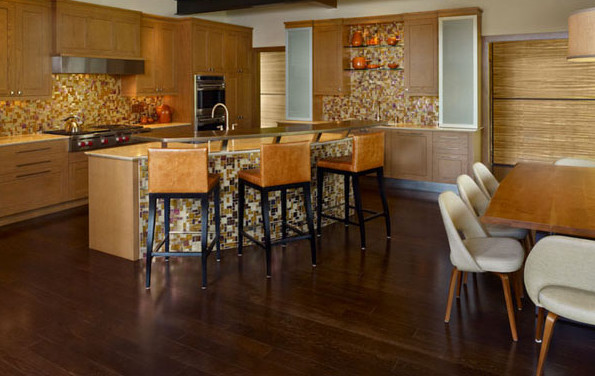
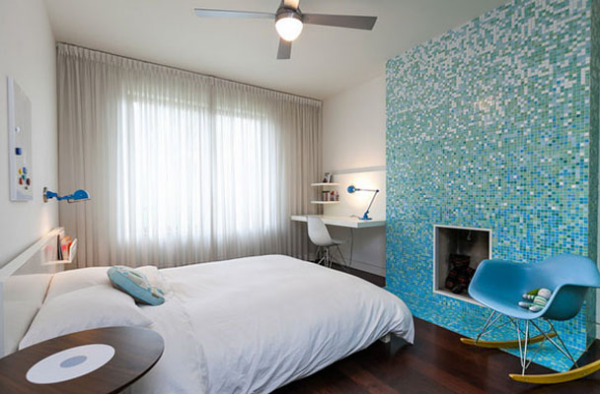
The market for finishing materials never ceases to amaze buyers with variety, quality, functionality, and beauty. Thanks to natural materials, it is possible to create a unique interior design.
Mosaic like finishing material appeared a very long time ago. If we consider the technology of its display, we can safely say that it arose back in Ancient China and Egypt, where some mosaic decor originated.
Mosaic in the interior is considered an indicator of wealth and well-being. Currently, marble is used to make mosaics. natural stone, smalt. The naturalness of raw materials is increasingly welcomed, but not everyone can afford such luxury due to the high cost of materials.
In order to meet the needs of average owners modern homes, manufacturers have developed simulating natural materials analogs that are in no way inferior to natural raw materials. They are also moisture-resistant, durable, and resistant to high temperatures.
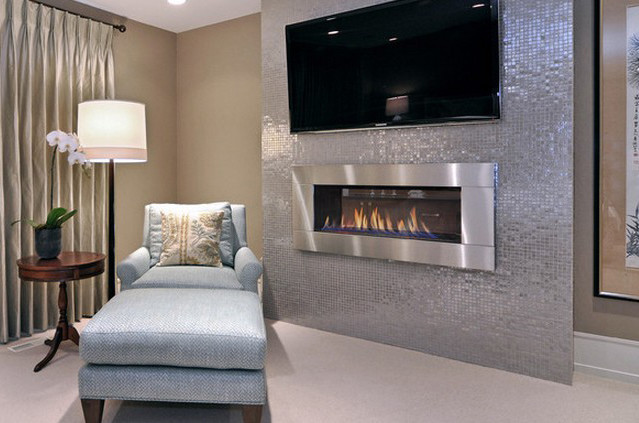
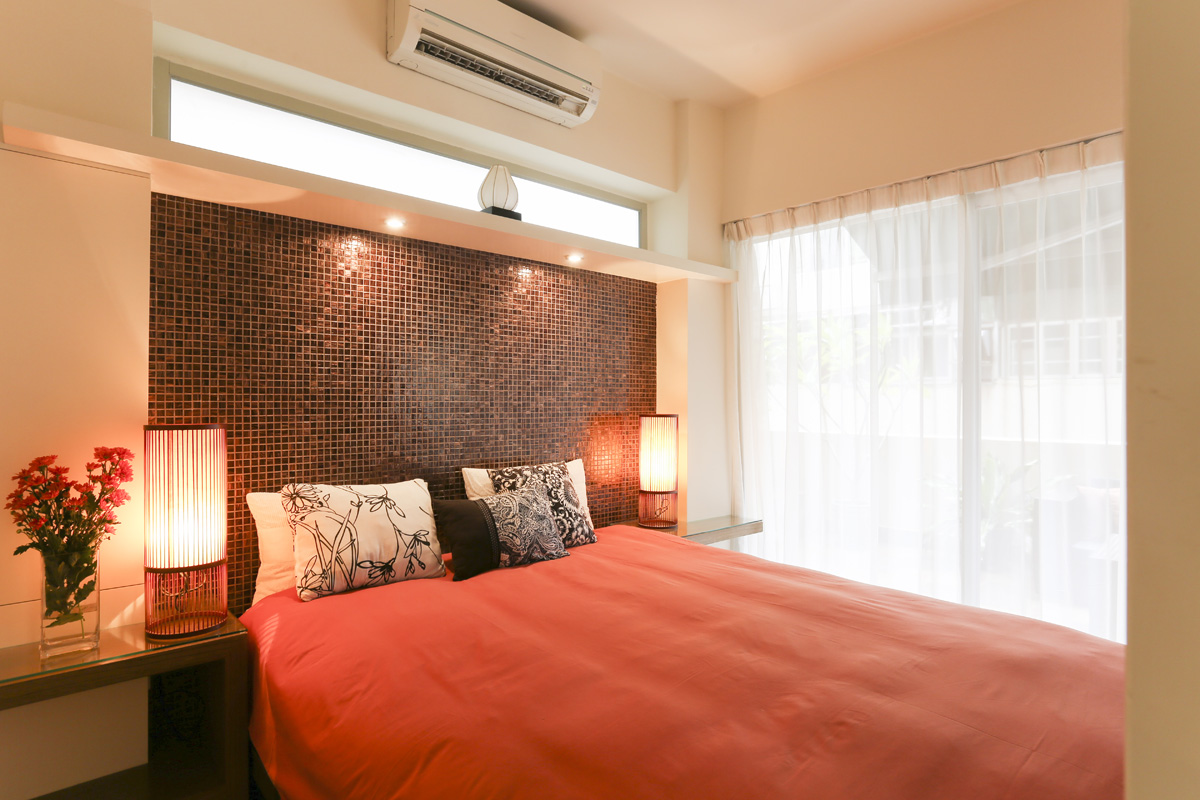
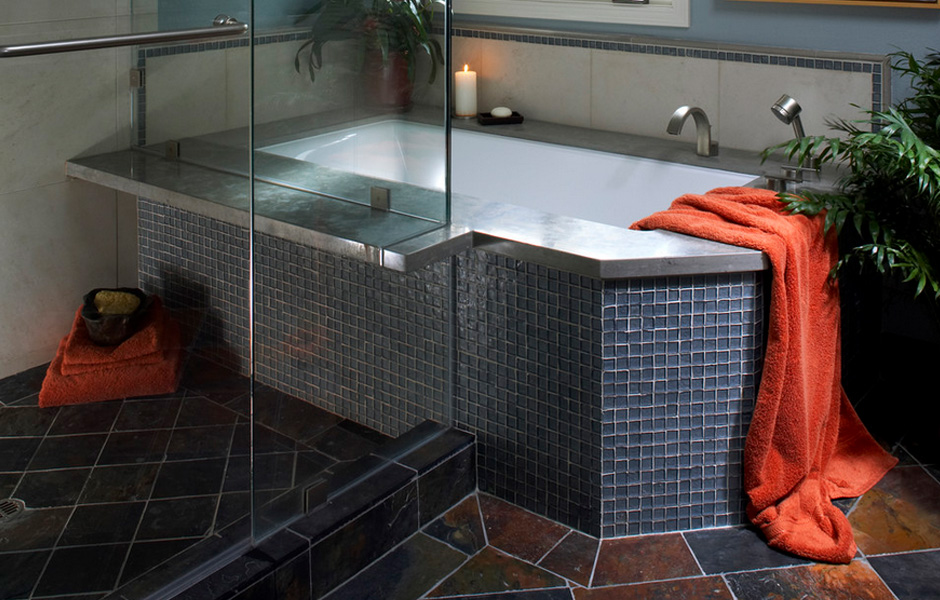

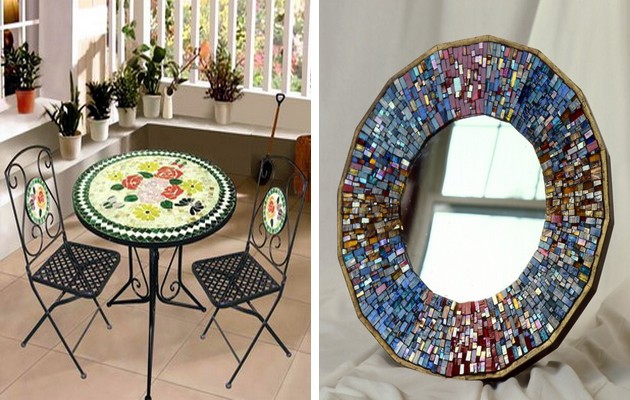
Varieties of mosaics
Mosaic in the interior is classified into the following types:
- glass (one of the most popular types, characterized by low cost and varied designs, among which are matte, gold, transparent, platinum, silver shades with and without additional decorations). It is possible to create original colors using appropriate layers of foil. This type of mosaic is resistant to environment, high humidity, high temperatures, aggressiveness detergents. It differs from other types of mosaics in its frost resistance, durability, and heat resistance. Suitable for finishing kitchens, bathrooms, fireplaces, countertops, floors, partitions.

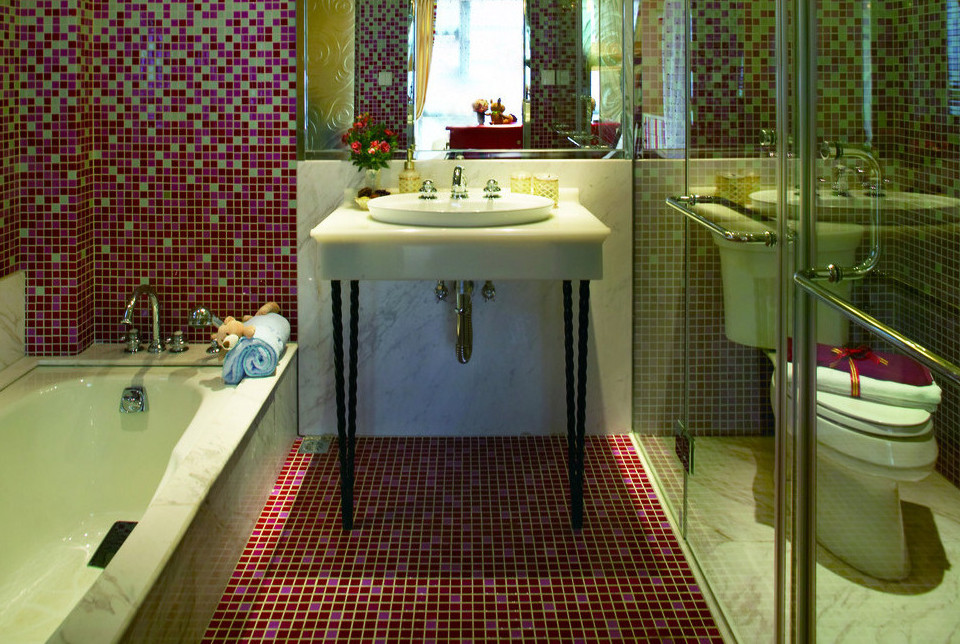
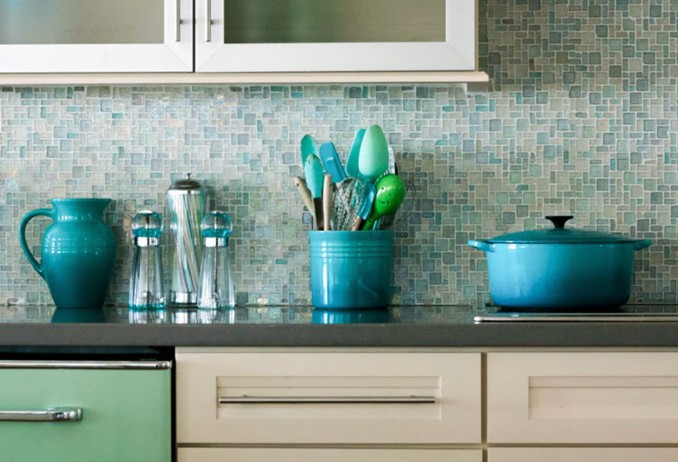
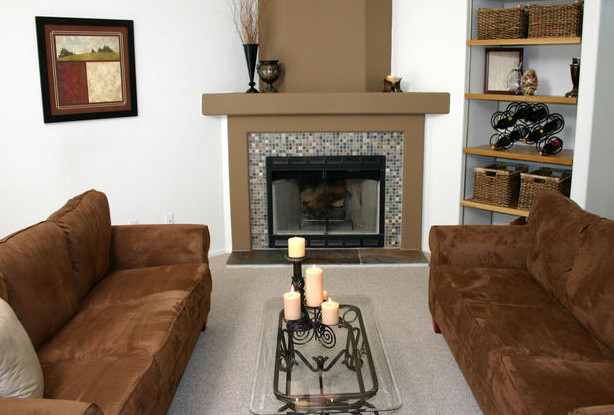
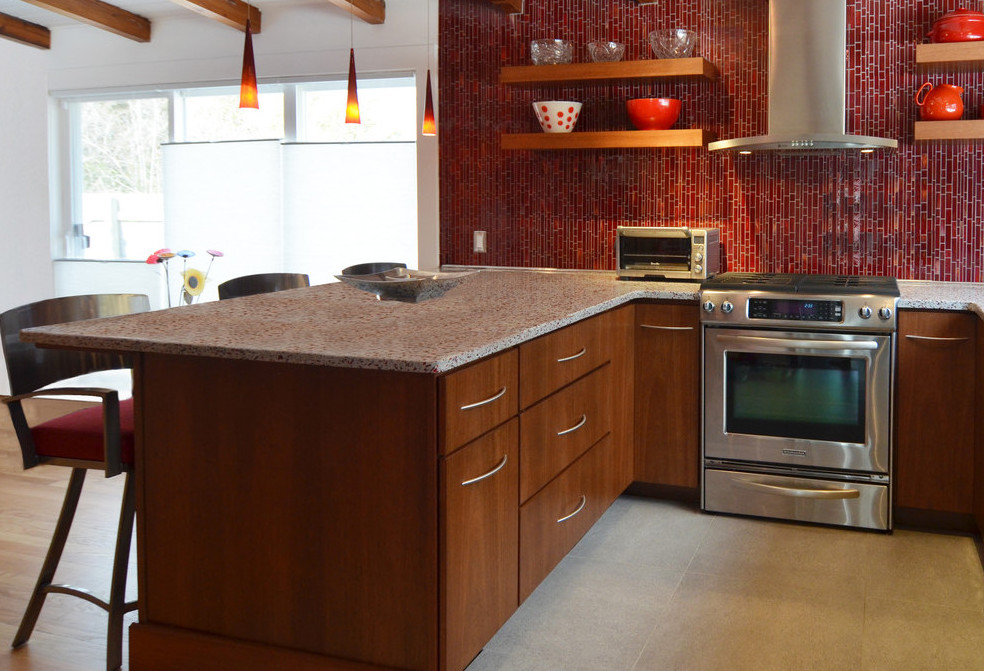
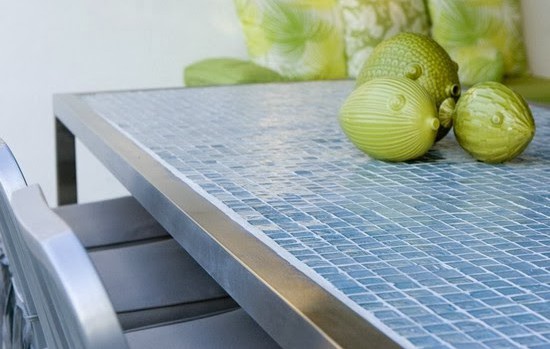
Advice: purchasing glass mosaic as flooring, pay attention to the slip coefficient. To avoid slipping on the floor, select mosaic fragments with a minimum slip coefficient. For bathrooms and restrooms, purchase mosaics with the maximum slip coefficient, because... in these rooms there is a possibility of a wet floor.
- ceramic (produced according to two technologies: like ceramic tiles and cut sheets of porcelain stoneware). The main task in finishing ornaments is the gradual alternation of matte-glossy zones of various tones. Features of this type of tile are increased strength and resistance to water. This makes it possible to use mosaics in the form of decorative accents and panels in the interiors of various rooms.
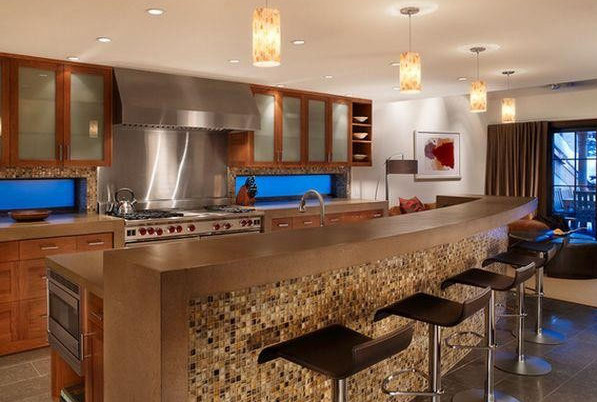

- stone (elite type of mosaic). It has several varieties: lapis lazuli, jasper, marble, travertine. This type of mosaic can be used to decorate: stairs, countertops, swimming pools, kitchen walls, bathroom walls, hallways, hallway floors. Often used for finishing steps, decorating entrances, doors and window openings, facades.
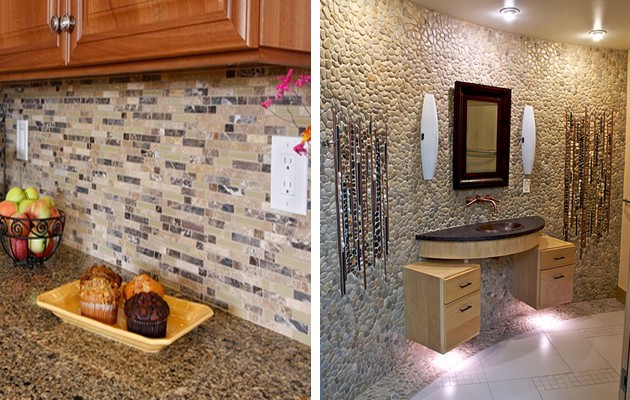
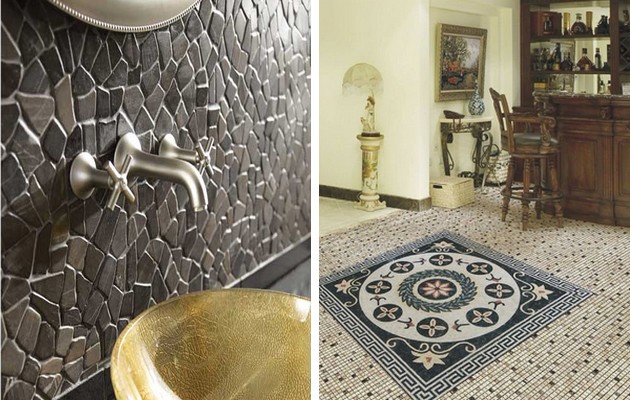
- smalt mosaic (the most expensive type, but at the same time, high-quality and practical). In appearance, smalt mosaic in the interior looks like smooth glass. The color palette is rich and bright. Mosaic shades have a glowing effect. This mosaic is suitable for decorating interior surfaces, including frequently loaded areas.

- metal mosaic (popular in wall decor). Manufactured in brass and stainless steel molds attached to a base made of plastic. It has different surface. Used as decorative inserts. Mosaic tiles have different shapes: oval, rhombic, rectangular, square.
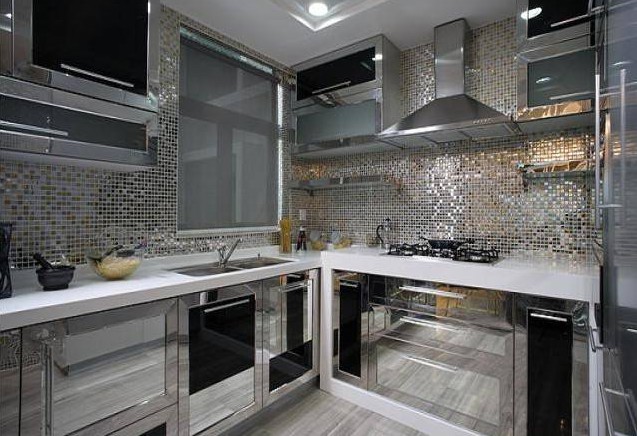
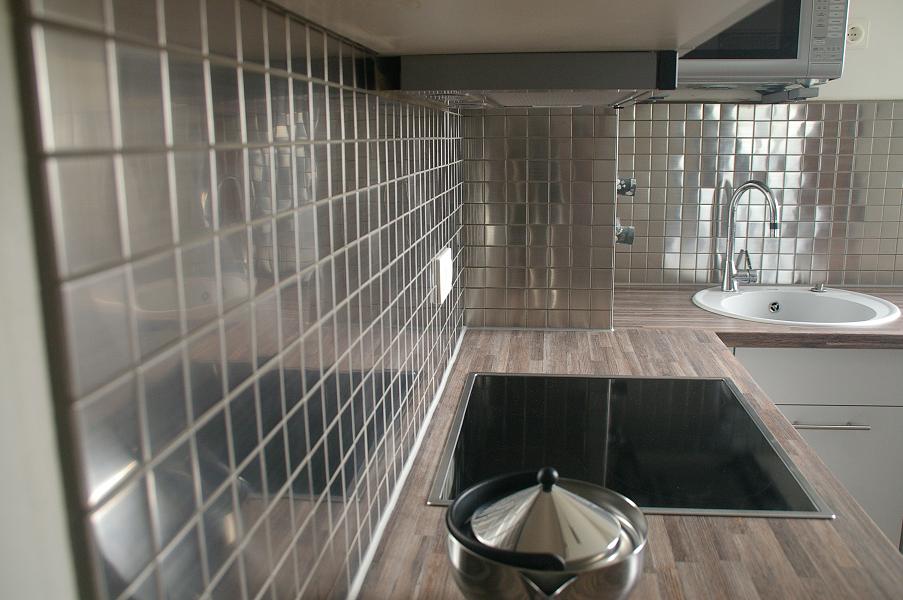
Dimensions of mosaics and methods of laying them
The mosaic is produced in the form of separate fragments various shapes and sizes. This important detail in finishing. To lay out a mosaic with high quality, it is better to assemble it into the necessary matrices.
On the inside, mosaic tiles are attached to each other to a mesh or special film. On supermarket shelves you can find ready-made matrices and panels. In online stores you can order mosaic compositions for interiors based on photos of the desired designs.
The mosaic is laid end to end. Attached using special adhesive bases and grouting pastes. The popularity of mosaic does not go out of fashion, since the beauty of its coating, resistance to external influences, durability make it indispensable in places where there are unevenness, differences, and the ends of surfaces.
In the kitchen it is better to use ceramic mosaics in matte shades or slab mosaics. It is possible to combine several types of mosaics both together and separately, creating an original, attractive interior.
Mosaic finishes are ideal for large, spacious kitchen spaces. It can be used as a working material for walls, countertops work surface, and also as decorative parts. For miniature rooms, creating light accents working surface of the wall. Manifold color palette far from the limit.
Advice: Multi-colored mosaics are also perfect for effectively decorating furniture with patterns, for example, the backs of chairs in the living room, cabinets, the surface of shelves, and stands in the kitchen.
When deciding whether to make a mosaic in the house or not, pay attention to its cost, which is determined depending on the naturalness of the materials, their quality, quantity, and special coating.
Once you decide to lay out the mosaic masonry yourself, you can successfully save on hiring specialist finishers, performing the work itself, and materials for repairs. Otherwise, furnishing an apartment will be expensive, especially if you hire professionals.
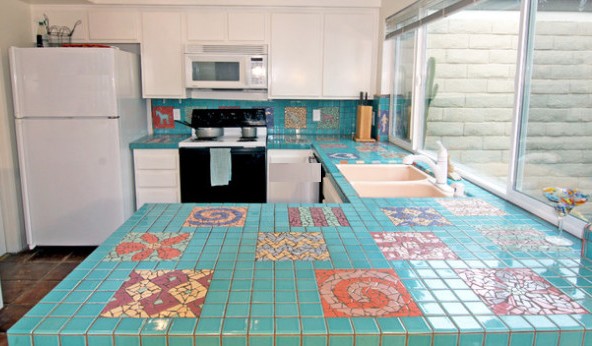
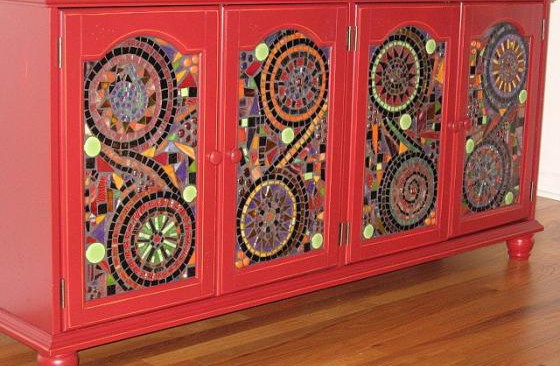

Unconventional mosaic decoration in the interior
Porcelain stoneware is considered a non-standard type of finishing. This inexpensive material, which is much stronger than ceramics.
Multi-colored mosaic glass and aventurine pieces are also used in the interiors. They are recommended to be used for decorating baseboards, tabletops, and window sills.
The main feature of sheet mosaic is the difference in materials for its manufacture. The sheet mosaic in the interior is somewhat similar to the well-known one tiles, but looks different. Attached to a mesh base, it is easy to cut, process, and lay out.
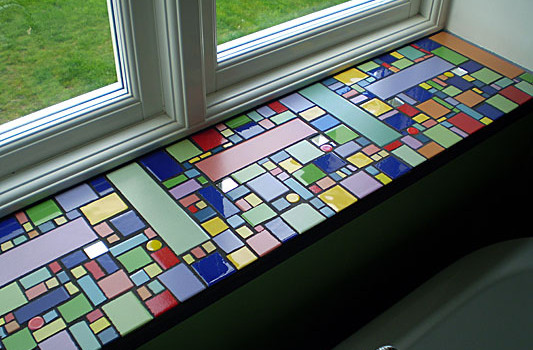
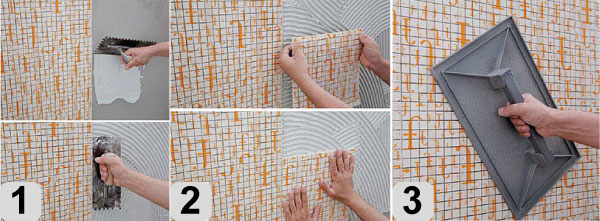
The most expensive diamond mosaic. Diamond pieces are used as a stylish, sophisticated, original decoration in design.
With the help of diamond finishing it is possible to create stunning decorative elements. Sets of this type of mosaic contain a detailed installation diagram with step by step photos, adhesive base, decorating rhinestones, grout paste, tweezers, mosaic fragments packaged in separate bags.
The entire process of laying out the mosaic, despite the complexity of joining, will not take much time. The only thing that is required from the owners is patience, perseverance, caution and accuracy.
It is enough to slowly “plant” the mosaic fragments on the glue in a checkerboard pattern or in a row. In addition to the sparkling interior, the design is characterized by creativity, creative approach, elegance. Mosaic decoration of a home can later become a hobby for creative personalities or their professional activities.
The originality and unlimited possibilities of using mosaic tiles make it an increasingly popular material. It can easily be used to cover the body of a bathtub, a protruding wall, kitchen countertop, use in the hallway and living room. Let's consider options and methods for decorating the interior with mosaic tiles.
Types of mosaic tiles
Mosaic tiles are a set of small elements of various shapes, from 1 to 5 cm, glued to a mesh or special paper, which keeps them together, at equal intervals. It can be made from stone and glass, ceramics and metal, plastic and porcelain stoneware, as well as more exotic materials such as coconut and bamboo. Such a wide range allows mosaic tiles to fit into almost any interior style, from loft to classic.
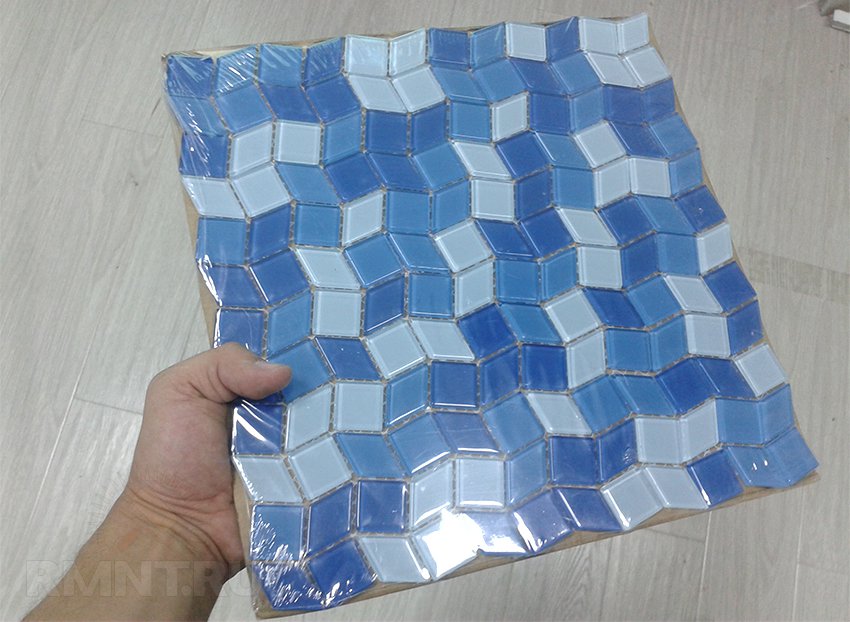
Stone mosaic tiles are most often made from marble, travertine, quartz or slate. Considering the good technical specifications, this type of tile is very often used for both walls and floors. For more demanding customers On the market there are also mosaics made of semi-precious stones, such as agate or malachite.
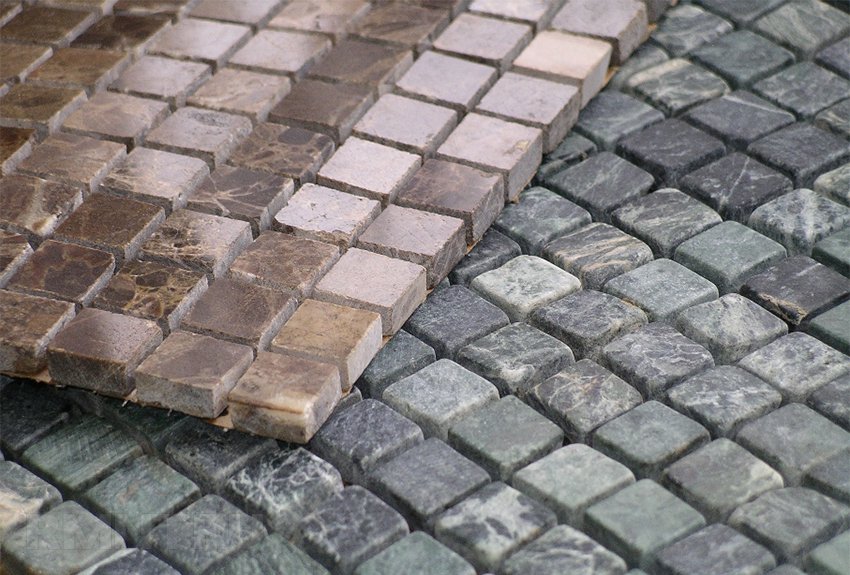
Glass mosaic tiles are especially recommended for installation on surfaces exposed to constant moisture, such as the walls of bathrooms, kitchens, swimming pools, and saunas. However, it is worth remembering that it is much less resistant to scratches, so it is not recommended to use it for flooring or countertops.
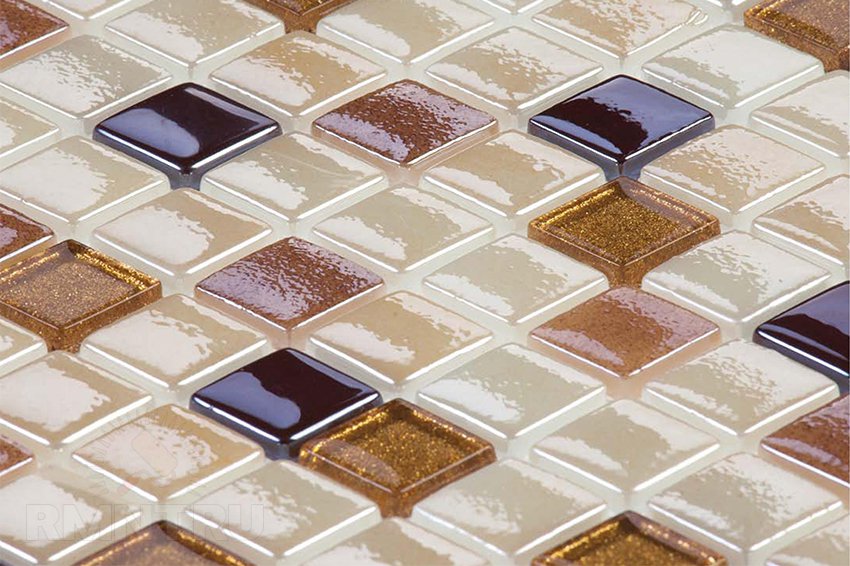
Ceramic mosaic tiles are intended for indoor use only. It is very moisture-intensive, so it is not suitable for the kitchen or bathroom.

Mosaic tiles made of aluminum, copper, and bronze are available on the market. This mosaic has a number of advantages, in particular, resistance to corrosion and temperature changes.

Mosaic tiles made of wood are an interesting proposal for people who want to bring nature into the interior of their home. Such tiles can be made from various breeds trees: oak, ash, wenge, merbau, cypress, bamboo. Its main advantage is hardness and abrasion resistance.
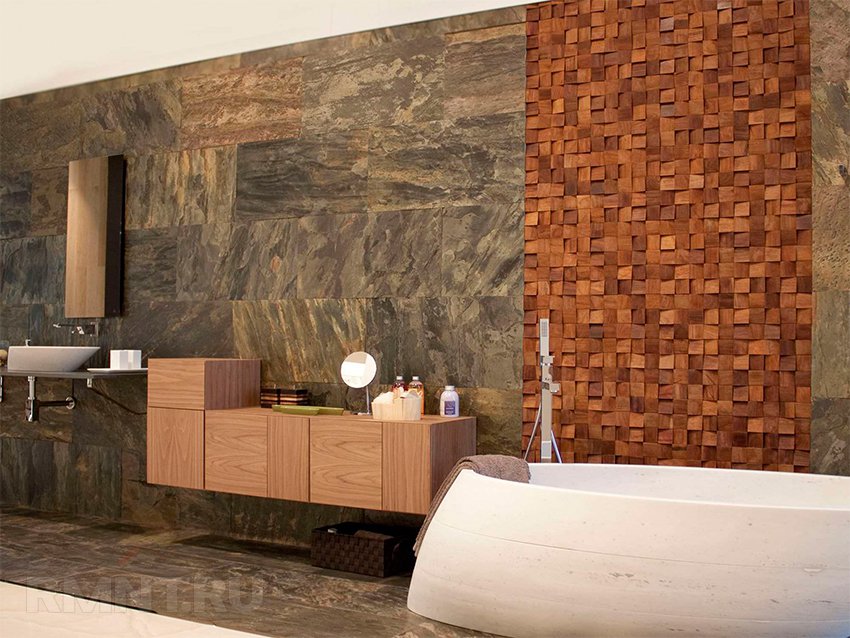
Ideas for using mosaic tiles
Mosaic tiles are an alternative to traditional ceramic tiles and offer much more design possibilities.
It is perfect for the bathroom. However, it should be borne in mind that covering walls and floors with only one mosaic can cause oversaturation, so it is better to use it, for example, as decor in combination with ceramic tiles big size.
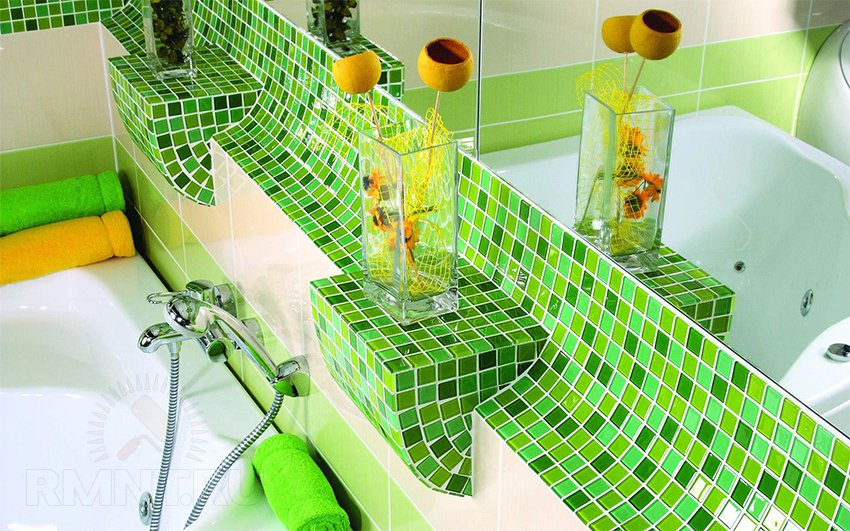 Colorful decoration: mosaic in the bathroom
Colorful decoration: mosaic in the bathroom
Mosaic is ideal for cladding shower cabins, swimming pools and saunas.
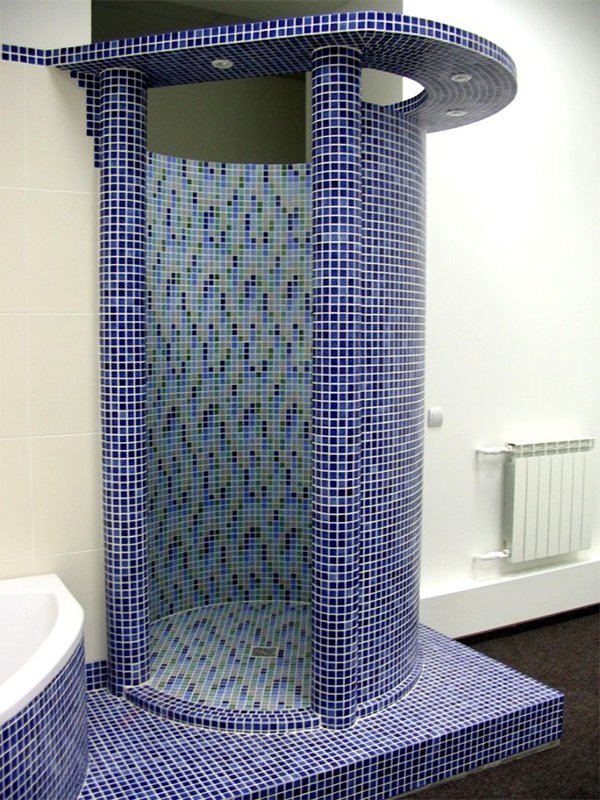 Shower cabin lined with glass mosaic
Shower cabin lined with glass mosaic
For decorative finishing arches, columns, niches and furniture.
 Easy to maintain and aesthetically pleasing
Easy to maintain and aesthetically pleasing
It doesn’t matter what style your kitchen is in: retro, classic, modern minimalism or pop art - mosaic will give a stunning effect.
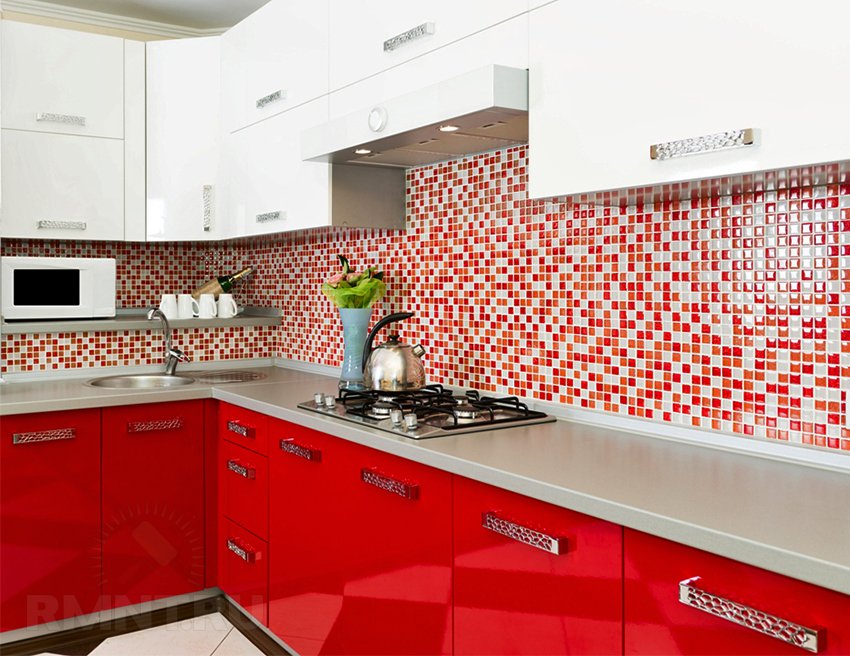 Bright mosaic above the countertop will enliven any kitchen
Bright mosaic above the countertop will enliven any kitchen
Mosaic is original decoration bedroom, dining room or living room in the form interesting decor, which will add charm and originality to the interior.
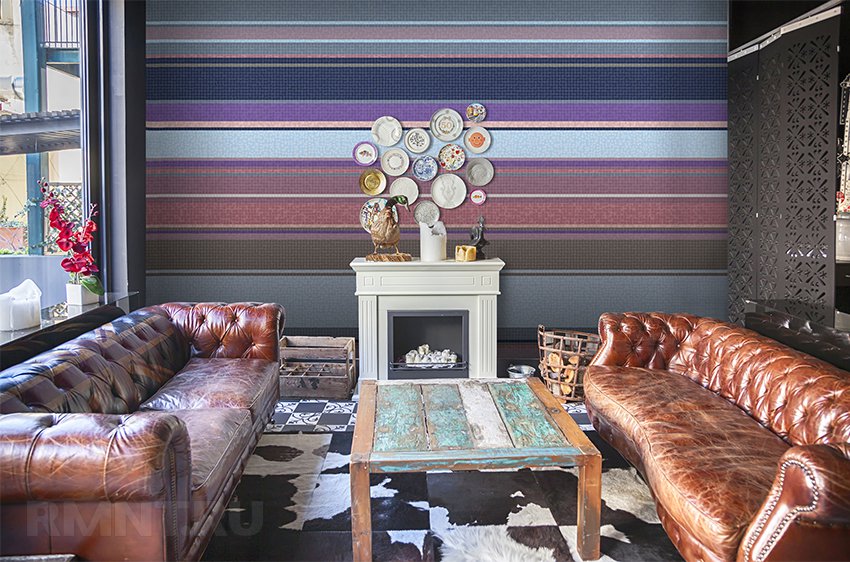 Color accents for inspiration
Color accents for inspiration
Laying mosaic tiles - step by step
Installing mosaic tiles is a simple process, but requires special precision and patience.
Materials and tools: tile adhesive, spatula for applying glue, level, spacer crosses, grout, sponge.
Surface preparation. One of the most important issues associated with laying mosaics is proper preparation of the base. The surface must be free of dust and dirt, dry and level. To improve adhesion, the surface must be coated with a primer. All measurements and markings of the wall are made in advance.
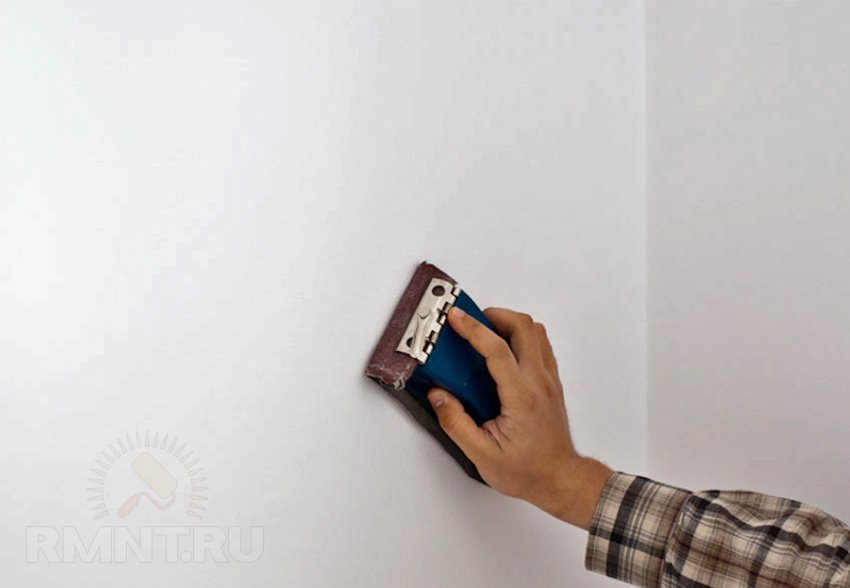
Applying glue. Glue is applied to the base thin layer. To apply it evenly, use a spatula with fine teeth. To avoid rapid drying, do not apply the adhesive solution over a large area at once.
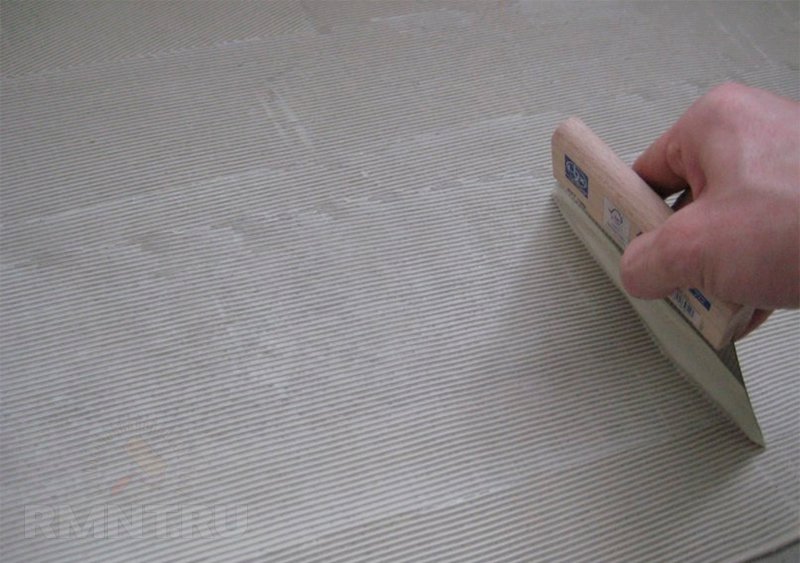
Laying tiles. Installation of mosaic tiles is carried out in small plates. Each one is pressed neatly against the wall. For adhesion strength, you can press all the sheets with a grout board or roll them with a rubber roller.
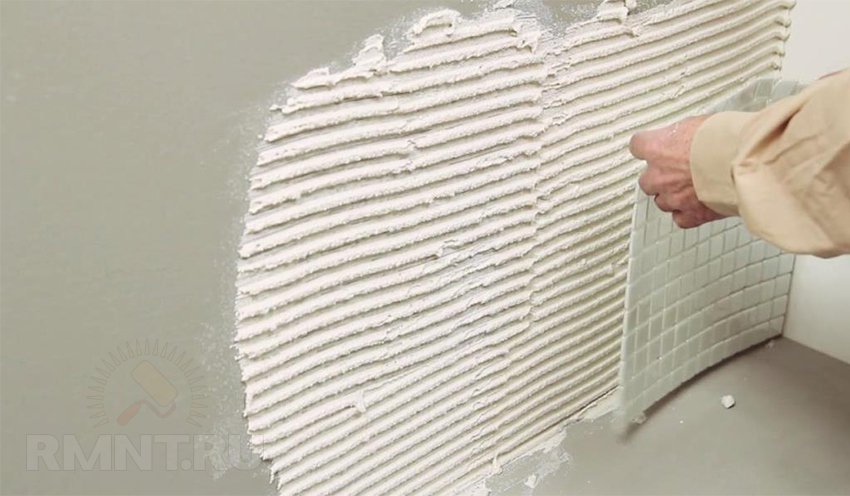
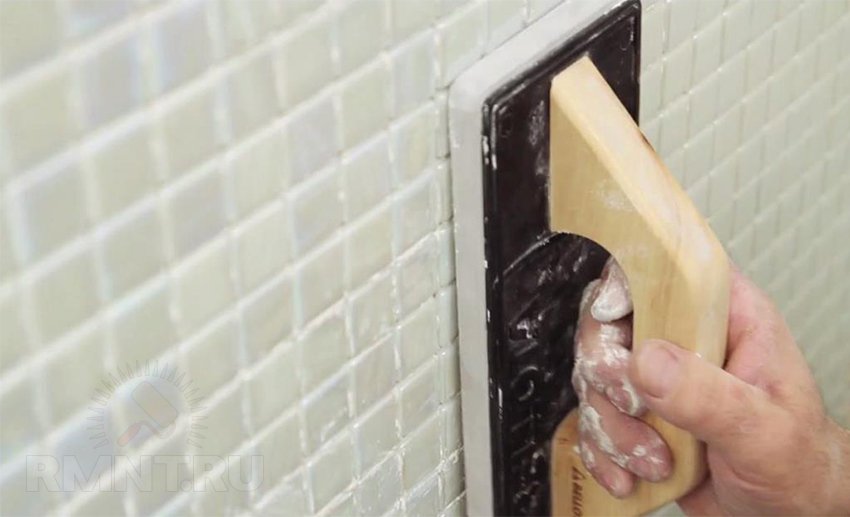
Any adhesive that appears on the surface of the mosaic should be removed immediately. Mosaic tiles on a grid are glued to the wall with a grid. And mosaic tiles on a paper base - with the paper facing up.
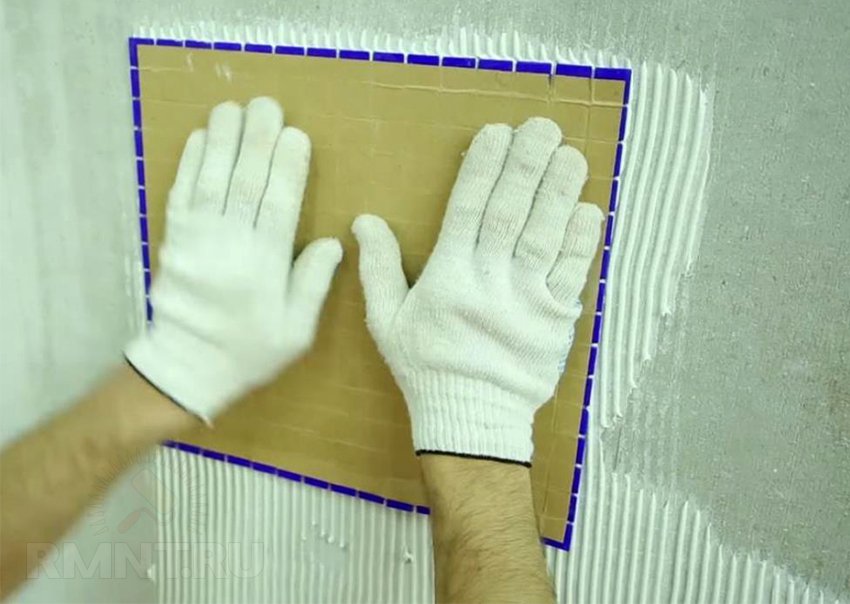
After the glue sets, the paper is soaked in water and removed. During the installation process, you should control the width of the seams between the plates. To do this, you can use distance crosses.
Grouting joints. No earlier than 24 hours after laying the mosaic, you can start filling the seams. Before starting grouting, the base is thoroughly cleaned of glue residues. The grout mixture is applied to the surface rubber spatula, carefully filling the seams to the full depth.
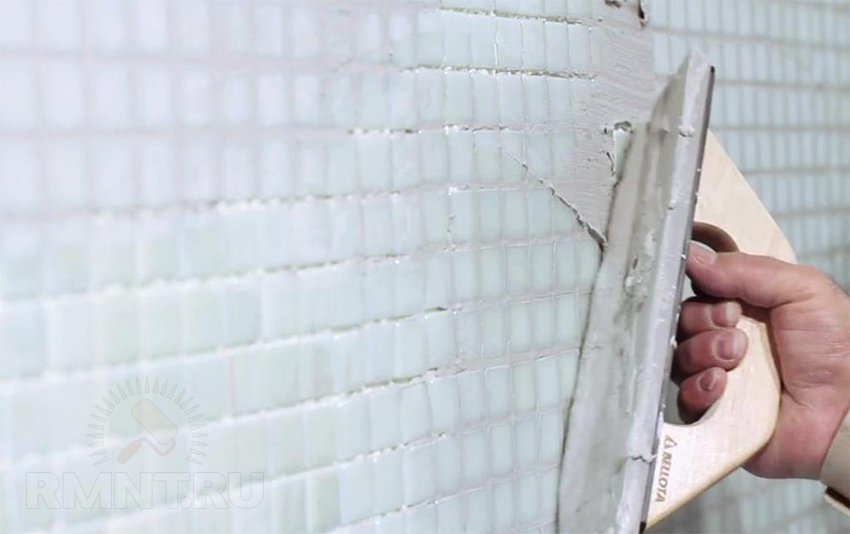
After drying, excess solution is removed with a slightly damp sponge.
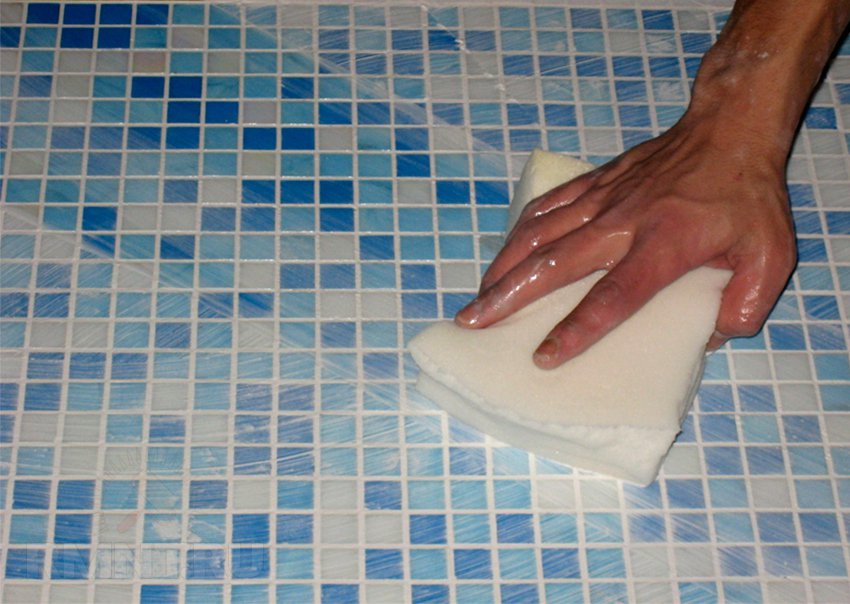
- When laying mosaics, the air temperature should be from +5 to +30 °C.
- The adhesive solution should be selected depending on the type of mosaic, type of base and location of application. For improvement visual effect It is better to use glue based on white cement, especially for marble and glass mosaics.
- In areas that are subject to constant contact with water and chemicals, it is better to use epoxy grout for grouting joints. This grout does not absorb water and other substances that cause persistent contamination.
Attention! Epoxy grout is not suitable for grouting tiles on heated floors.
- the most win-win option, which has long earned the reputation of “beauty for centuries.” In architecture and design, there are many materials for decorating and protecting surfaces, but only mosaic allows you to create both ornamental decors and complex plot compositions that will fill the house with a lively, endlessly changing play of colors and light, and the life of its inhabitants with joy.
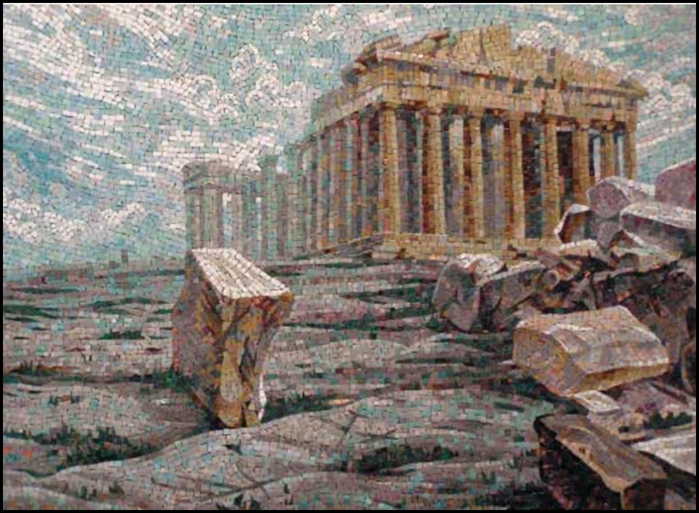
Mosaic in the interior of the living room
In this room, ceremonial in its purpose, the decorative possibilities of the mosaic are primarily taken into account. This can be a panel placed above a sofa or fireplace, and if the room is spacious, then it can occupy the entire surface. This one will flicker and shimmer like natural light, and when lit by candles, and the play of shades gives the image the effect of movement.
Since mosaic is a heat-resistant material and resistant to sudden temperature changes in the range from +15 to +145°C, it can also be successfully used for the external cladding of fireplaces themselves. The room will also be decorated with a border under the ceiling, inserts in the floor, cladding of columns, window sills and niches with lighting. Using multi-colored mosaics, you can create spectacular patterns on the surface of furniture - for example, on the backs of chairs, table tops, shelves. Depending on the design, you can combine tesserae of different shapes, textures and degrees of transparency and gloss.
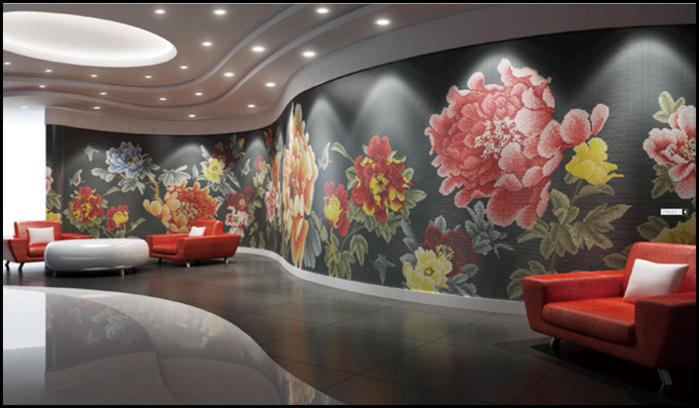
Mosaic in the bathroom interior
Bathroom mosaics must first of all be practical. The most common option for finishing walls and ceilings is glass mosaic, which is resistant to dirt, chemical exposure and temperature changes. Smalt is more resistant to abrasive wear and is therefore suitable for installation in places with increased abrasion, for example, on the floor or on interior and outside bathtubs or sinks. You can cover all the walls of the bathroom with mosaics or lay out panels, veneer a mirror frame, or limit yourself to elegant borders.
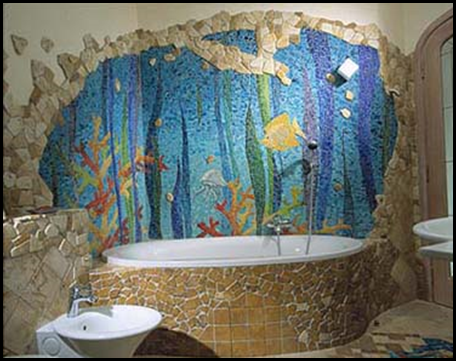
If you don’t have enough money, but you want to “revive” the interior with mosaics, you can leave a few empty spaces before laying the tiles and fill them with colorful chips - the room will immediately look brighter original look. The favorite color scheme for the bathroom is a combination of blue, turquoise and white, creating a feeling of freshness. Decorating a bathroom with multi-colored tesserae should be done with caution - the interior may turn out to be too colorful. However, there is a way out: large areas, such as walls and floors, are covered with a single-color material, and multi-colored mosaics are used as bright inserts - accents. Choosing glass mosaic for flooring, you should pay attention to such characteristics of the material as the slip resistance coefficient. To stay barefoot on a dry floor, it is enough to choose a series with the lowest value (R9), and for surfaces that can be flooded with water - with a higher one.
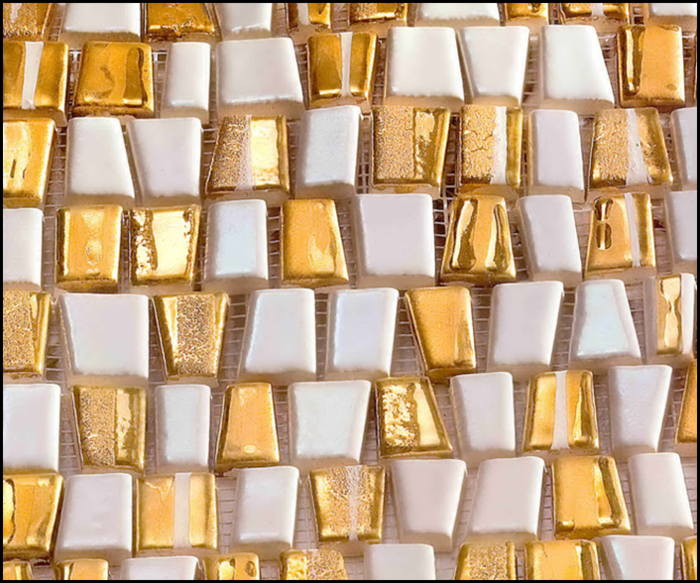
Mosaic in the interior of the hallway
The main surfaces for mosaic decoration here can be the floor and walls. They will be decorated with either a plot panel, or, conversely, small decorative inserts, which will significantly enliven a room usually devoid of daylight. Since a mirror is a necessary attribute of the hall, it can be decorated with a mosaic frame (the beauty of such a frame will be emphasized by two lamps mounted in the upper part).
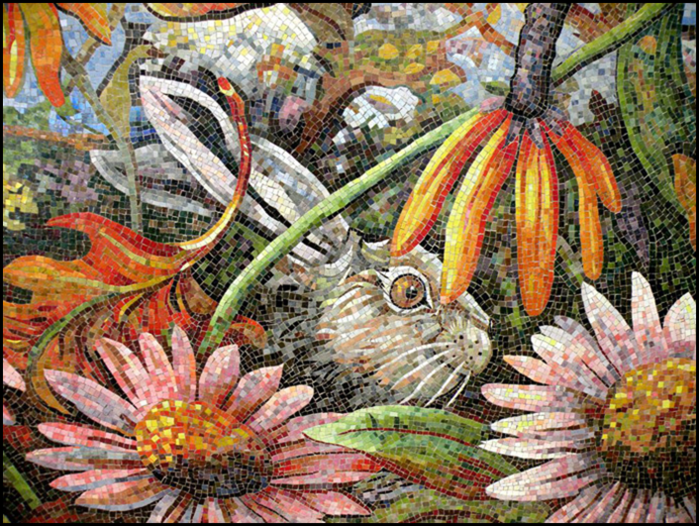
Mosaic in the kitchen interior
An ornamental panel made of shiny or matte tesserae will decorate the “apron” above the sink or stove. To create a general ensemble, you can decorate with mosaic patterns dinner table, cupboard doors or work surfaces.

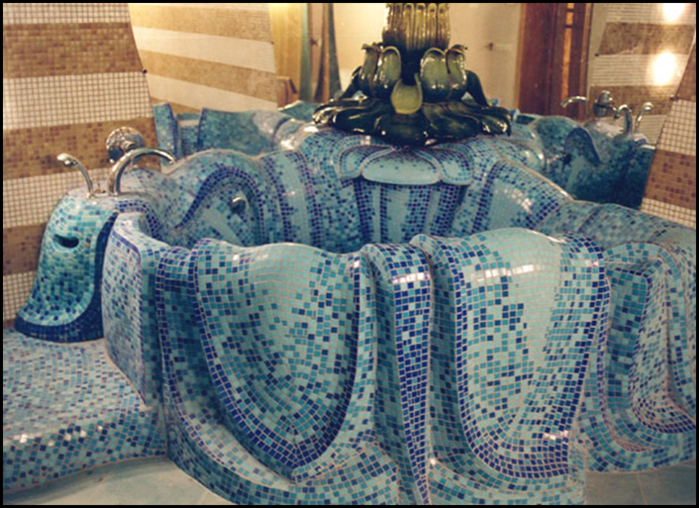



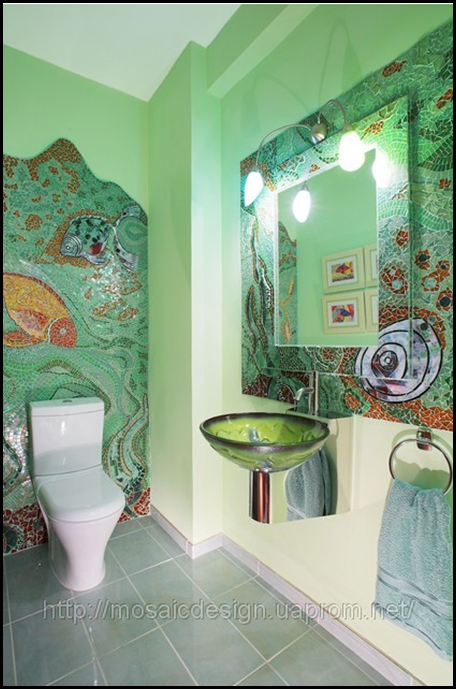
![]()
